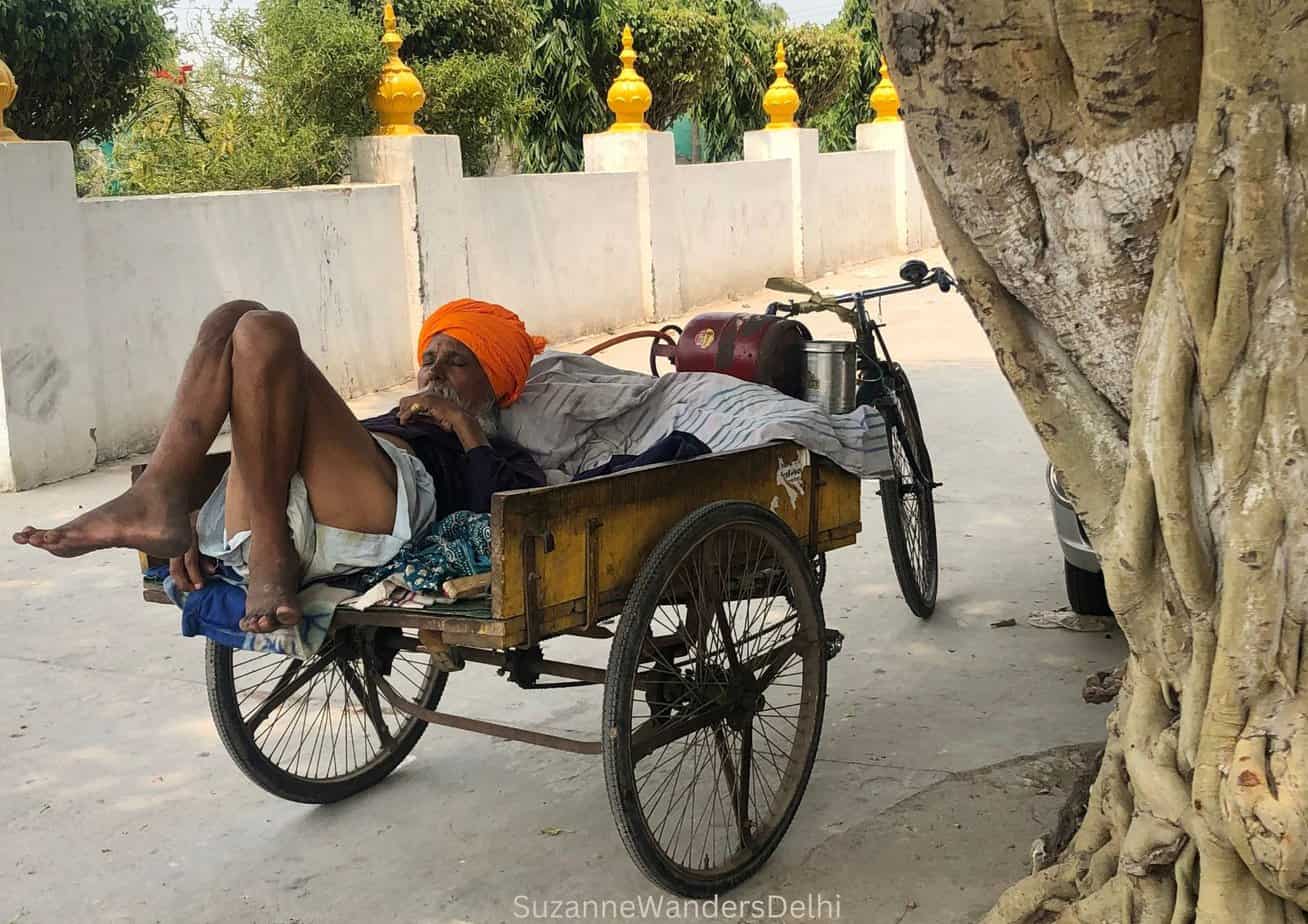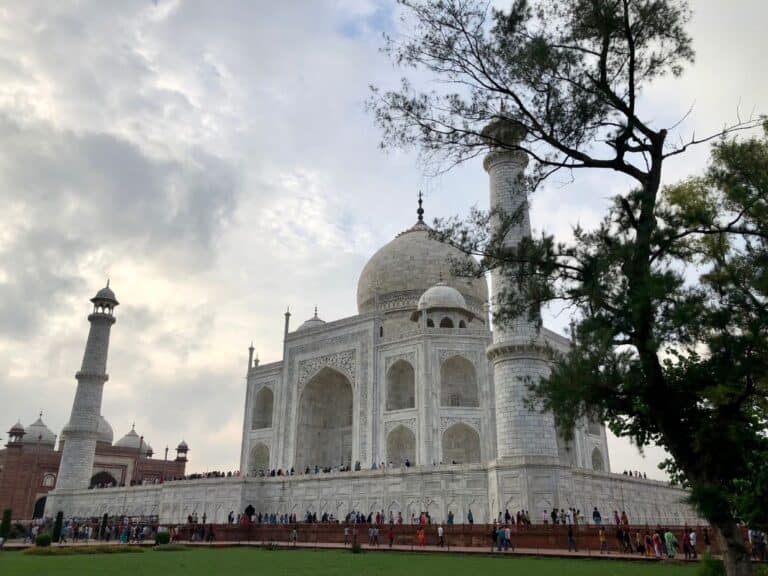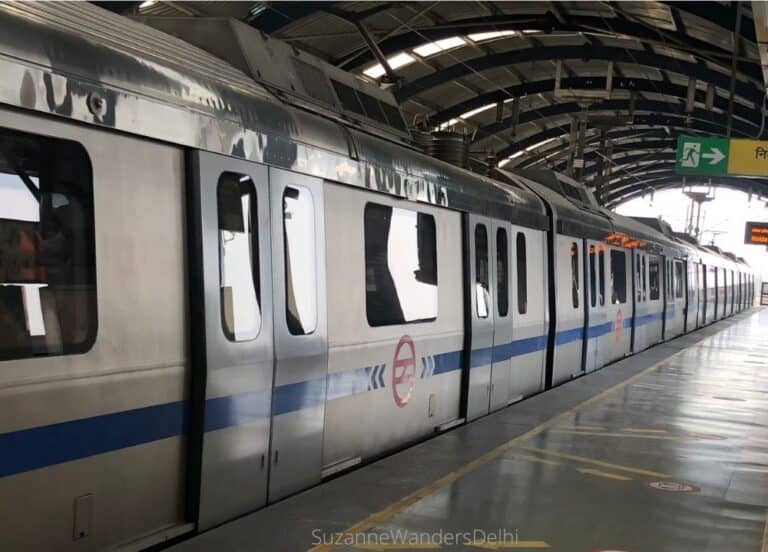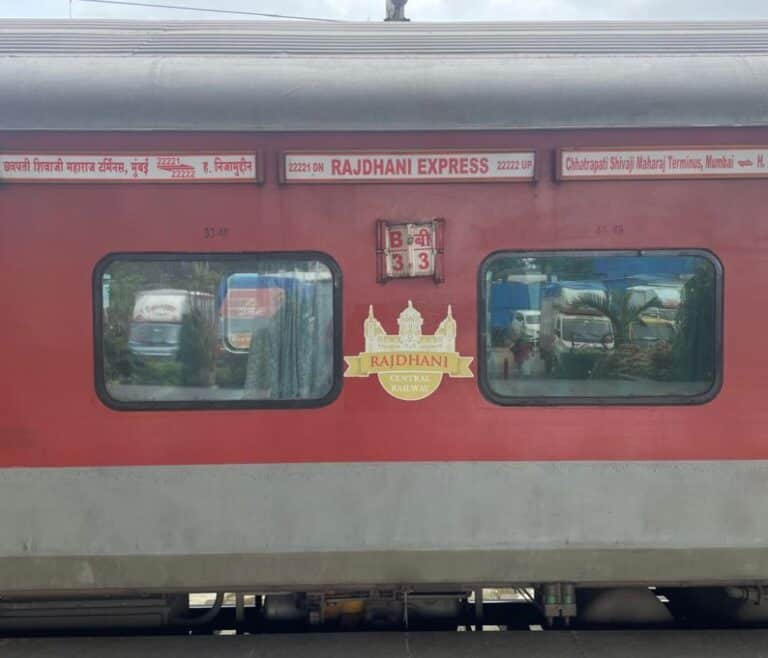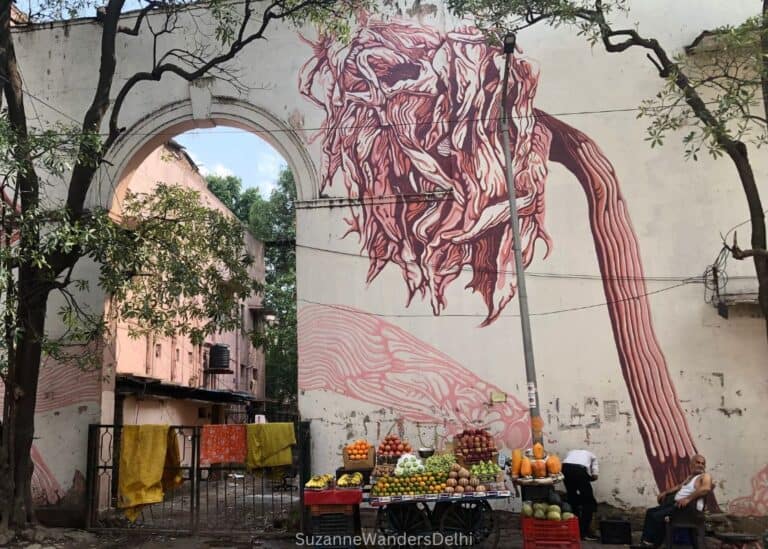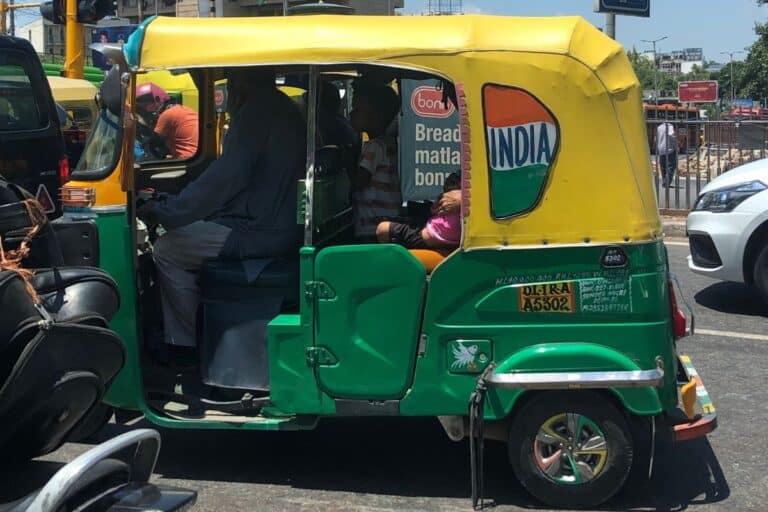First Time in Delhi: Complete Guide and Itineraries for Delhi

Is it your first time in Delhi? Travelling to Delhi for the first time is an unforgettable experience. Most visitors find India’s capital city overwhelming, I certainly did when I arrived for the first time. But Delhi is a fascinating city with so much history and culture, you will be captivated if you give it a chance. I live in Delhi and this is my best advice for first time visitors.
Travel Tips for First Time Visitors in Delhi
- There is no Visa on arrival in India for most countries – only citizens of Japan, South Korea and the UAE can apply for visa on arrival. Nationals of many countries can apply for an e-visa here: https://indianvisaonline.gov.in/, but not every country qualifies for e-visa. Check the visa regulations well in advance of travel. A paper visa can take weeks to obtain in some cases.
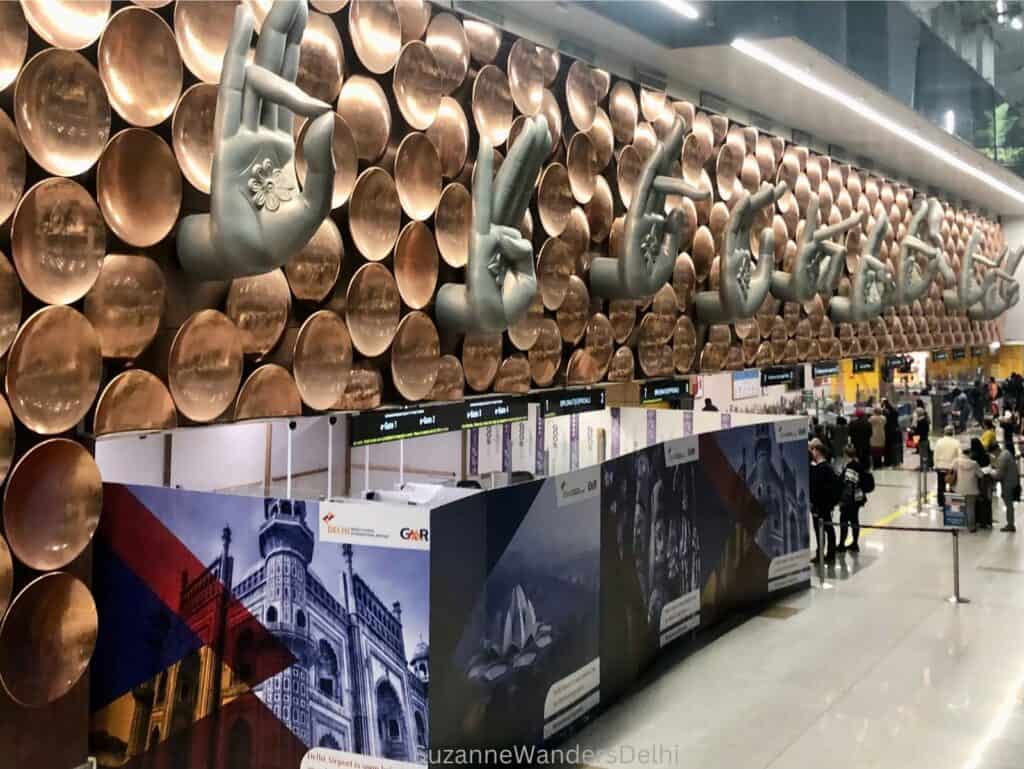
- Get a local SIM card at the airport – Airtel, Vi (formerly Vodafone) and Reliance Jio are located just outside of customs by the exits. I have used all 3 of these major carriers and I recommend Airtel or Reliance Jio. Trying to get a SIM card as a tourist in Delhi can be challenging, sometimes they request all kinds of documents. Unless you are staying in India for a long time, get the SIM card at the airport – it is much easier!
- Take an Uber from the airport – apart from the metro, Uber is the best and most cost effective way to get into Delhi from the airport. Once you have your SIM card activated, book your Uber. The Uber pick-up point at the airport is in the parking garage to the far right as you exit. See my full guide on how to get into Delhi from the airport.
- You can take a pre-paid taxi from the airport – buy your ticket from the pre-paid taxi booth located just outside the exit across the first road. Do not listen to the touts who will approach you as you exit the airport. They will try to charge you 3-4 times the going rate. Do not listen to any driver who says your hotel is closed, burnt down, or moved locations. Insist the driver take you to the hotel at the address provided.

- You can take the metro from the airport into Delhi – the metro airport express line runs between 4:45 am and 11:30 pm and is the fastest and cheapest way to get into Delhi. If you don’t have a ton of luggage and aren’t arriving in the middle of the night, it’s a good option. The metro entrance is to the far left as you exit the airport.
- Do not listen to the scammers – if you look like a tourist you will be approached by a multitude of touts and scammers. They will try every trick in the book. Basically, ignore anyone who approaches you and do not believe them when they tell you a particular monument or site is closed. If you do need help, pop into a shop or restaurant and ask there.
- Be prepared for the beggars and ignore them – this can be hard for first time visitors in Delhi, but you only perpetuate the cycle by giving money. Begging is organized in many Indian cities, it’s part of a cartel. If you buy a food or grocery item for someone, they often return it to the shop for cash. Personally, I do sometimes give to a clearly disabled or elderly person, but never to anyone else, especially children. Children will tug on your clothes and follow you persistently, but keep moving and ignore them – they will eventually give up.
- Do not drink the tap water – it’s not safe. Use only bottled or filtered water for drinking. Some visitors won’t brush their teeth with tap water but I always have and it’s been fine.
- Bring the right power adapter – India has C, D, and M type electrical outlets so remember to bring the right adapter for your devices. Electrical voltage is 230V and the standard frequency is 50Hz.
- There is almost always a foreigner price and a local price for monuments and attractions – if it’s your first time in Delhi, you’ll notice the foreigner price is usually substantially higher than the local price. The good news is that there is often a separate line-up for foreigners which is much shorter than the local line-up.
ATMs and Exchanging Money if It’s Your First Time in Delhi
ATMs in Delhi
ATMs are everywhere and often give the best conversion rates. Some ATMs give the option “with or without conversion.” Always select WITHOUT conversion. Proceeding with conversion authorizes the bank operating the ATM to do the conversion instead of your local bank, usually at higher rates.
Not all ATMS take foreign cards – look for an ATM with the logo of an international banking system like Cirrus, Maestro, AMEX or Visa. Transaction fees also vary bank to bank. I usually use HDFC or ICICI bank machines.
Many ATMs only allow a withdrawal of INR 10,000 at a time. You can withdraw more, but you will have to do it in multiple transactions.
Where to Exchange Cash in Delhi
Avoid banks and hotels, which usually have terrible rates. Forex Money Exchange has a number of locations across Delhi. You can check their daily rate here: Forex Money Exchange website
For cash exchanges I use these two places which both have competitive rates:
- Damini Money Changer: M Block Market, GK1 (don’t ask me why, but he sells perfume too) 10:00 am – 8:00 pm, closed Sunday
- Tradex Financial Services: L-4, Connaught Place (next to Haldiram’s) 10:00 am – 8:00 pm, closed Sunday
Getting WiFi or a Data SIM Card in Delhi
India has excellent WiFi and launched the 5G network in 2022. There’s a number of cell service providers in Delhi: Reliance Jio, Vi (formerly Vodafone) and Airtel are the most reliable. WiFi and data is inexpensive, I pay INR 699/month for data and cell service.
If you didn’t get a SIM card at the airport (the easier option, but might be more expensive) head to a Reliance Jio, Vi or Airtel shop to get a pre-paid SIM card. Be prepared to provide your passport, a passport size photo, entry visa and possibly proof of residence or where you’re staying. It should be activated while you are in the shop.
Public Transportation in Delhi
The Delhi Metro
First time visitors in Delhi are always surprised at how good the metro is. It is an excellent system and considered one of the best in the world. It’s by far the best way to move around the city. The metro is cheap, efficient, easy to use and extremely clean. For female travellers, the first car in the moving direction is reserved for women only. I use the metro regularly and have always felt safe.
The network is vast and goes all over Delhi and into the suburbs of Noida and Gurugram as well as the airport. See my complete guide on how to use the Delhi metro. Trains run 5:30 am – 11:30 pm.
Local Buses
Delhi also have a vast system of local buses, but I must admit I have never ridden one. The metro system is so good there’s never been a need to ride a bus. Plus, they are extremely crowded and not entirely safe for females, especially after dark. If you look inside a Delhi bus, you’ll see most of the passengers are men.
Auto-Rickshaws
If it’s your first time in Delhi, you will notice auto-rickshaws or tuks tuks are widely used. They are an excellent option for shorter distances or getting you from the metro station to your hotel or vice versa.
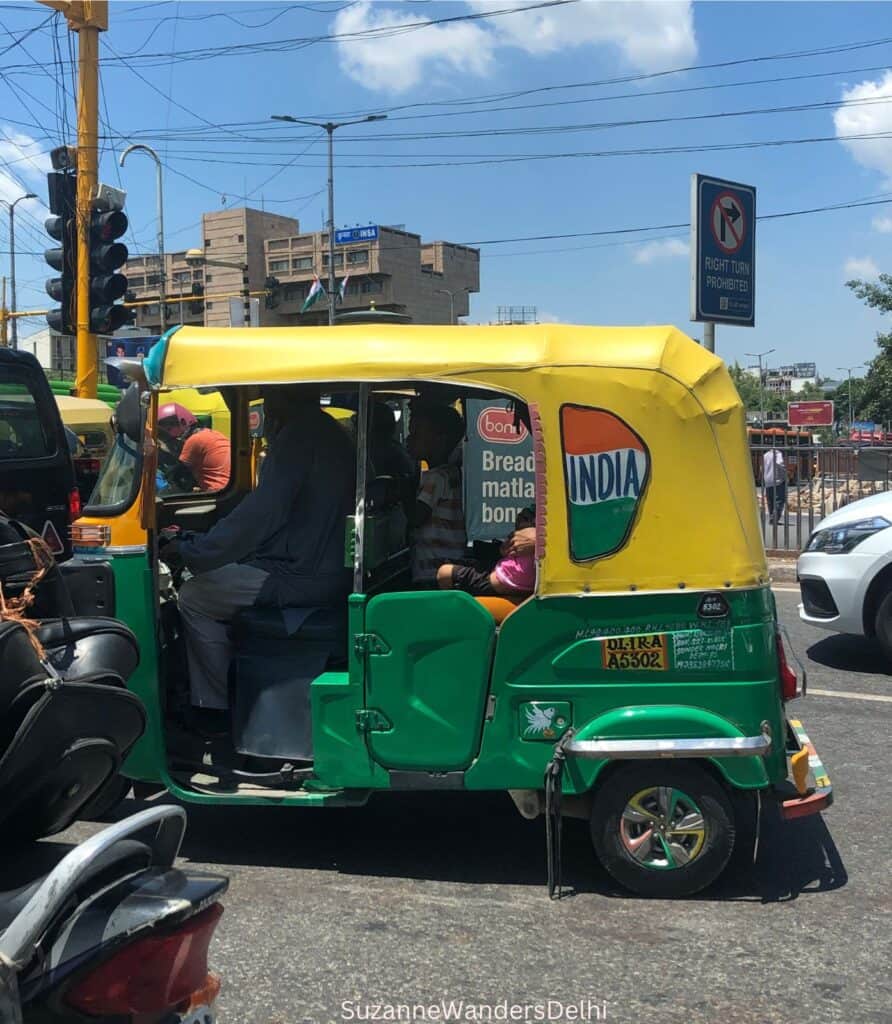
Always negotiate the price before getting in and expect to pay between INR 50-80 for a few kilometres. Prices go up at night, when it’s raining, or if there are several passengers. Auto-rickshaws are always waiting outside metro stations, markets, malls and Delhi’s monuments and attractions.
Using a Ride-Share App in Delhi
Uber and Ola (India’s version of Uber) are widely used all across the Delhi NCR (national capital region). Personally, I prefer Uber because almost every time I use Ola the price increases during the ride.
Both have apps you download onto your phone. Of course you’ll need data to use them – but it’s easy and cheap to pick up a SIM card at the airport when you arrive.
How Expensive is Delhi?
Well, it can be extremely expensive or very cheap, depending on your choices. It is the nation’s capital and has a large diplomatic community, so there is no shortage of luxury 5 star hotels, beautiful, expensive restaurants and bars, high end shopping, and private transportation.
And while there is extreme wealth in the city, the per capita income in 2023 was just over $US 5,500 per annum. It’s easy to do everything on a budget in Delhi – food, transportation, shopping and accommodation, even for a first time visitor.
| Budget | Expensive | |
| Tea/Coffee | $0.15 (chai wala on the street) | $3.00 (Starbucks) |
| Meal | $5.00 (vegetarian meal at a casual sit-in place like Kake Da Hotel in CP) | $45.00 (luxury restaurant like Spice Route in the Imperial Hotel) |
| Transportation | $1.00 (Delhi metro across city trip) | $10.00 (Uber across city trip) |
| Accommodation | $30.00 (Bed & Chai Guesthouse, 2 star) | $250.00 (Shangri-La Eros, 5 star) |
| Site/Attraction | Many are free, particularly those off the beaten path | $7.50 (admission at the Red Fort, a UNESCO site) |
Tipping in Delhi
It is common practice to tip in Delhi, but not on everything. Tip amounts depend on the level of service received and personal preference and can vary, but these are the standard tips in Delhi.
Generally speaking, at a sit down restaurant, a hairdresser or other personal care service a tip would be appropriate, and 10% is standard. Some restaurants add a 10% service charge automatically, so check your bill first before leaving a tip.
There is no need to tip street food and chai vendors or auto rickshaw drivers. When taking Uber, you could round up the figure if you want to leave a small tip. If using a private driver for a full day, an INR 500 tip would be appropriate.
Where to Stay in Delhi if It’s Your First Time
The best areas to stay in for a first time visitor are South or Central Delhi, this includes New Delhi. Almost all luxury and mid-priced hotels are in these areas.
Many monuments and attractions are located in South and Central Delhi, and the metro is well connected there.
Avoid Paharganj and Old Delhi neighbourhoods. Old Delhi is fabulous in terms of historic significance (and wonderful to visit for a day), but it’s noisy, congested and not the safest area to return to after dark. Paharganj is known as the backpacker area. It’s near the New Delhi Railway Station and like Old Delhi, it’s congested and noisy but without the historic significance.
I don’t understand why so many budget and first time visitors in Delhi end up in Paharganj. There are better budget options in much nicer parts of the city.
These are my top picks for Delhi. If you want more information and options about accommodation in Delhi, check out where to stay in Delhi for every budget.
Imperial Hotel ($$$$)
This is my favourite Delhi hotel. It is a beautiful, heritage hotel full of charm and character. The location is excellent, right on Janpath within walking distance of many attractions and Connaught Place.
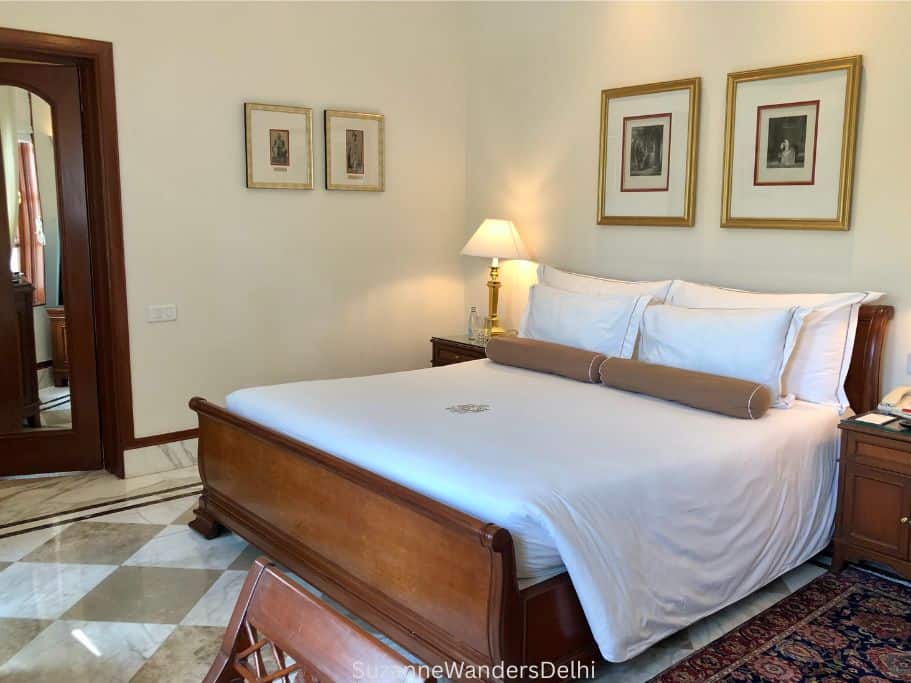
Art lovers will feel right at home, the hotel has an impressive collection of British art displayed throughout the property.
The Imperial goes out of its way to make guests comfortable – service is impeccable.
🚩 Check prices and availability for the Imperial Hotel
Radisson Blu Marina Hotel Connaught Place ($$$)
If it’s your first time in Delhi, the Radisson Blu Marina is a good choice because of its location right in the centre of Connaught Place. For first timers, Connaught Place is a good way to acclimatize to Delhi.
Numerous restaurants, cafes, stores, a couple of movie theatres, art galleries, the Palika Bazaar and the Delhi metro are located in this white, colonnaded shopping and commercial hub. It’s the unofficial centre of Delhi and many sites and attractions are easy to reach from here.
🚩 Check prices and availability for the Radisson Blu Marina Hotel Connaught Place
Prakash Kutir Bed & Breakfast ($$)
This is my favourite guest house in Delhi and I’ve stayed here multiple times (before I moved to Delhi).
It’s a wonderful bed and breakfast run by the Gupta family who are incredibly kind and welcoming. The location is excellent – it’s in the residential neighbourhood of Hauz Khas in South Delhi, close to the metro, local market with restaurants and shops, and many of Delhi’s sites and attractions.
A hearty and delicious breakfast is included with the room rate. Prakash Kutir is very popular, book as far in advance as possible.
🚩 Check prices for Prakash Kutir Bed & Breakfast
Bed & Chai Guesthouse ($)
Bed & Chai Guesthouse is a great alternative to the budget accommodation in the backpacker area Paharganj. The guest house isn’t fancy, but it’s clean, comfortable and in an excellent neighbourhood, Greater Kailash I.
It’s close to the well known M Block market and metro. There’s an onsite cafe, free WiFi and a rooftop terrace.
🚩 Check prices for Bed & Chai Guesthouse
Hosteller Delhi ($)
Hosteller Delhi is a very popular Delhi hostel, located in the south east part of the city, close to a metro station. They have good WiFi and an onsite cafe. They offer shared and private rooms, all at budget-friendly prices.
🚩 Check prices for Hosteller Delhi
Airbnbs
South Delhi is the best area to rent an Airbnb. The neighbourhoods of Greater Kailash I, Hauz Khas, Defence Colony, Lodhi Colony, Safdarung, Jorbagh, Nizamuddin West, Chanakyapuri, Green Park and Panchsheel Park are all good for a first time visitor in Delhi. I like and have stayed at this Airbnb:
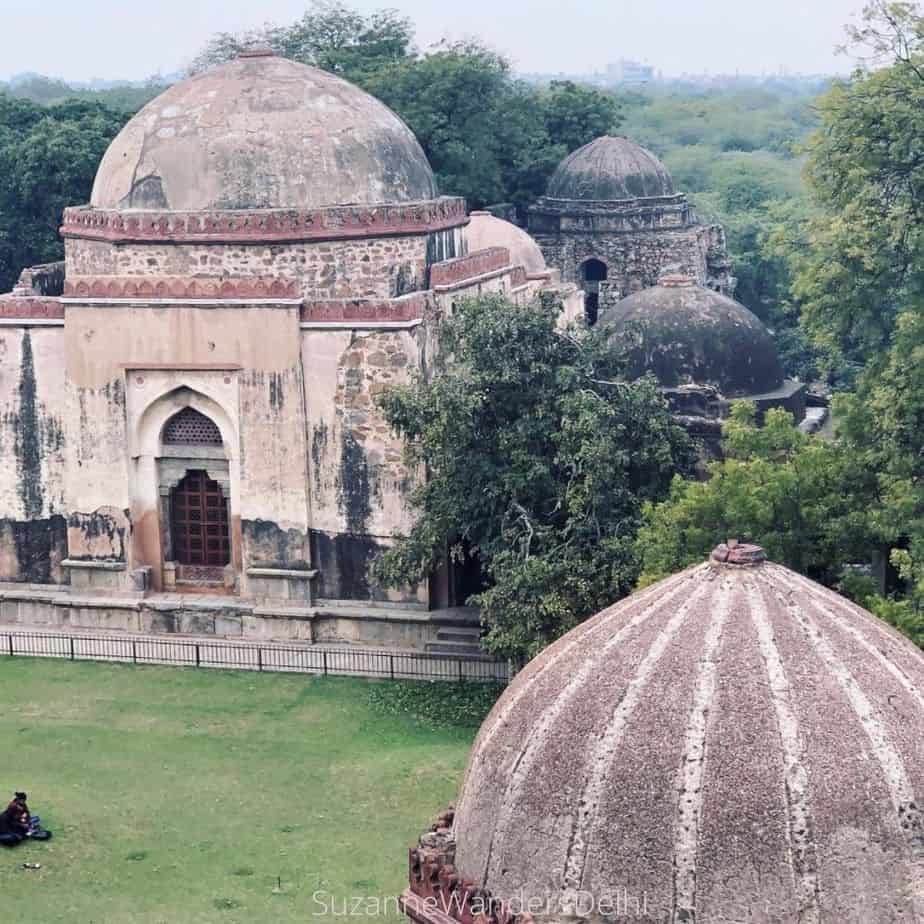
Ashrams
Delhi has many ashrams that offer accommodation for those wishing to deepen their yogic understanding and look within. These are not hotels, but if you are looking for an opportunity to slow down and recharge your emotional and spiritual batteries, an ashram stay might be for you.
How to Stay Healthy in Delhi
First of all let me reassure you, Delhi has world class medical and dental care. Better than what I’ve experienced in Canada. In fact, I prefer to get all of my medical and dental work done here.
Not only are the facilities and professionals top notch, it’s also extremely inexpensive compared to prices in Canada, USA and Europe. That being said, you should have travel health insurance, just in case.
- Get the right vaccines before arriving in India – check the Centre for Disease Control and Prevention website for up to date information on recommended vaccines. Carry the vaccine certificates with you, especially yellow fever which is mandatory if arriving from certain countries. I have been asked for evidence of this at Delhi immigration.
- Do not drink the tap water or water that may not be bottled or filtered – Delhi water is not safe to drink. Better restaurants, hotels and many Airbnbs have filtered water. Stick to bottled water while out and make sure the top is sealed. Do not drink anything with ice cubes (unless they were made with filtered water) and do not eat the shaved ice treats sold on the streets.
- Eat the street food but be careful – one of the best things about Delhi is the street food. Not only is it cheap, it’s delicious. Read more on how to eat local and stay healthy, but the most important tips are to eat at busy places and wash your hands before eating.

- Use mosquito repellent – mosquitos in India can carry dengue and Chikungunya. Odomos is a good local brand repellent that comes in spray or cream form and is widely available.
- Stay hydrated – Delhi can be very hot, temperatures soar to 45C in the summer (but hopefully you won’t be here then). It’s important to carry water and keep hydrated.
- Prescription drugs and non-prescription medicines are easy to find – Delhi has lots of great pharmacies but you may need to provide the generic name of the medicine (ibuprofen instead of Advil, for example). Medicine is very inexpensive also. Lots of visitors stock up before returning home.
How to Dress in Delhi
India is a conservative country in many aspects and this pertains to clothing. Men can wear pretty much anything, but it’s more restrictive for women. Of course, you can wear whatever you choose, but to avoid unwanted attention I recommend dressing conservatively.
Women should wear clothing that covers knees and shoulders, and definitely no cleavage. Clothing is much less conservative in clubs and bars and almost anything is acceptable there.
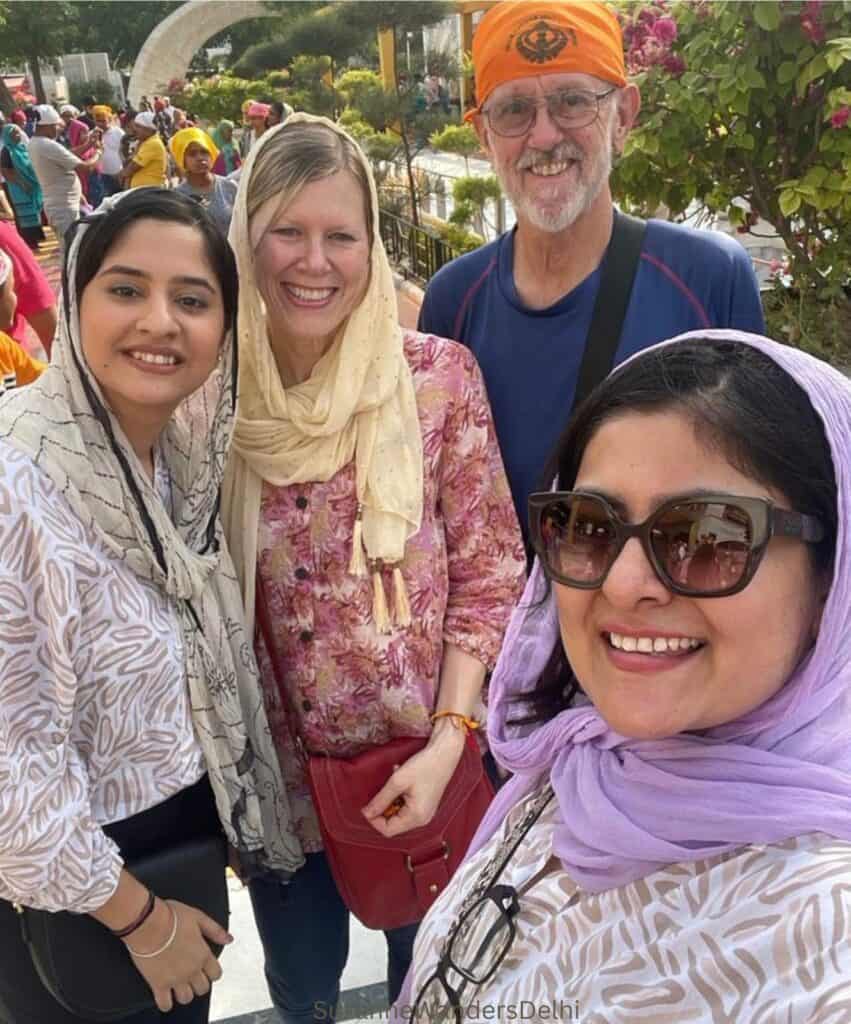
Keep a dupatta with you at all times (an Indian scarf – the number one fashion accessory of Indian women). A dupatta is very handy; use it to cover your head if visiting a Sikh temple or mosque, as a wrap to keep warm or cover shoulders, and around your face to keep dust off while riding on a motorcycle or scooter.
During the hottest months, Indian clothing like loose cotton pants and kurtas are the most comfortable. One of the best and cheapest markets in Delhi to shop for Indian clothing is Central Market Lajpat Nagar.
Best Time of the Year to Visit Delhi for First Time Visitors
The months of February, March, October and November are the best time to visit Delhi, especially for a first time visitor. Temperatures are pleasant and the pollution levels are relatively good in these months.
The summer and monsoon months are very hot and humid, and most people avoid going out during the day. Temperatures can reach over 45° C in May and June.
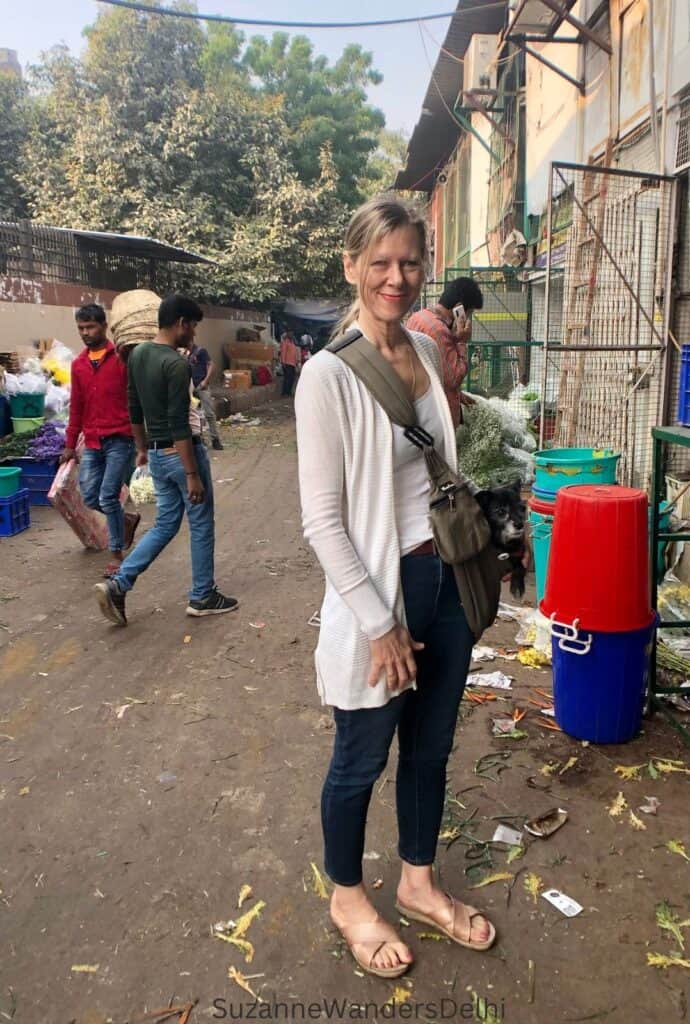
December and January are cool and foggy, with increased levels of pollution due to several factors, the stubble burning of fields in the Punjab region being one of them. Most places do not have central heating, just electric or oil heaters and it can get chilly indoors as temperatures go down to the single digits.
Read my guide to visiting Delhi in winter if you’re planning to come at that time.
Delhi 5 Day Itinerary for First Time Visitors
Delhi is a massive metropolitan city. It’s worth planning your trip and grouping the days by area so you don’t waste time. I’ve structured the itineraries below based on this and included the must see sights with some more off the beaten path things.
The itineraries do not have to be done in order, you can mix and match the days, but save Old Delhi until you are feeling a bit more acclimatized. Don’t feel bad if you can’t get everything done, it’s a good excuse to come back. Here are quick shortcuts to the itinerary for each day:
- Day 1: Safdarjung Tomb, Lodhi Art District, Lodhi Garden, Khan Market, India Gate
- Day 2: Hauz Khas Village, Deer Park, Shri Jagannath Mandir, Tombs of Green Park, Dilli Haat INA
- Day 3: Agrasen ki Baoli, Jantar Mantar, Gurudwara Bangla Sahib, State Emporiums on Baba Kharak Singh Road, Connaught Place
- Day 4: Qutab Minar, Mehruali Archeological Park, Bahai Lotus Temple, Central Market Lajpat Nagar
- Day 5: Red Fort, Chandni Chowk, Khari Baoli, Jama Masjid, Raj Ghat
- Want more? Here are more things you can do in Delhi
👍 You can buy tickets online for sites associated with the Archaelogical Survey of India, including Safdarjung Tomb, Jantar Mantar, Hauz Khas Fort, Qutub Minar, Red Fort and Humayun’s Tomb. They are INR 50 cheaper this way and it’s a good way to avoid any ticket line up. This is the website: https://asi.payumoney.com
Day 1: Safdarjung Tomb, Lodhi Art District, Lodhi Garden, Khan Market, India Gate
This is what I consider a soft landing in Delhi. These are good sites for a first time visitor in Delhi to get acclimatized. None of these sites are overly busy, and this Day 1 itinerary will take you through some of the nicest parts of the city.
1. Safdarjung Tomb
This is going to be a full day so start early at Safdarjung Tomb. It’s open at 7:00 am and if you’re lucky you’ll see the peacocks that often frequent the tomb in the mornings. Built in 1754 at the decline of the Mughal empire, it is the very last garden tomb built by the Mughals in India.
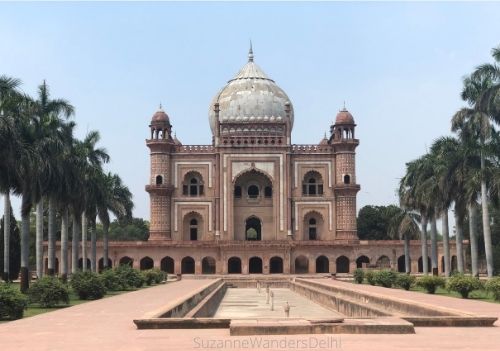
It’s a lovely, atmospheric tomb and elaborately decorated. Because the tomb was built during the decline of the Mughal empire it was constructed with poor quality material, as well as building blocks that were removed from other tombs.
It was built for Nawab Safdarung, a vazir in the Mughal court. At the time of his death the vazir had been ousted from court, and his son had to plead with the Emperor for permission to build the mausoleum.
- Hours & Admission: 7:00 am – 9:00 pm daily, INR 300 (children under 15 free)
- Nearest Metro station: Jorbagh (Yellow line) exit Gate 2
2. Lodhi Art District
From Safdarjung Tomb, walk across Lodhi Road and turn right onto Second Avenue in Lodhi Colony. This lovely enclave is home to India’s first open air art district. There are over 50 massive art murals by contemporary artists from around the world painted on the facades of residential buildings. Many address social and environmental issues.
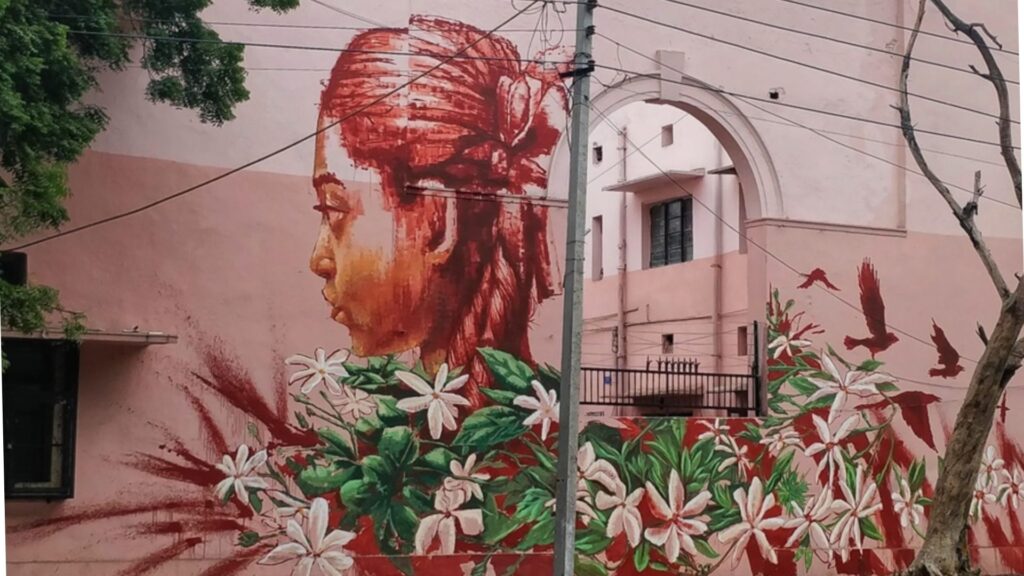
The murals are located between Jorbagh Road, Meharchand Market, Second Ave and Fifth Road. Stop and have a coffee at one of Delhi’s best coffee shops, Devan’s South Indian Coffee & Tea. They make a seriously good cup of coffee.
- Hours & Admission: 24/7, free
- Nearest Metro station: Jorbagh (Yellow line) exit Gate 1
3. Lodhi Garden
Lodhi Garden is the most popular park in Delhi, and as a first time visitor you will be captivated. Stroll along the treed pathways and you will come across beautiful and well preserved tombs dating back to 1444 from the Sayyid and Lodhi dynasties. Also scattered in the park are the beautiful domed gateway of Bara Gumbad, a three domed mosque, and the lovely Athpula bridge built by the Mughal ruler Akbar.
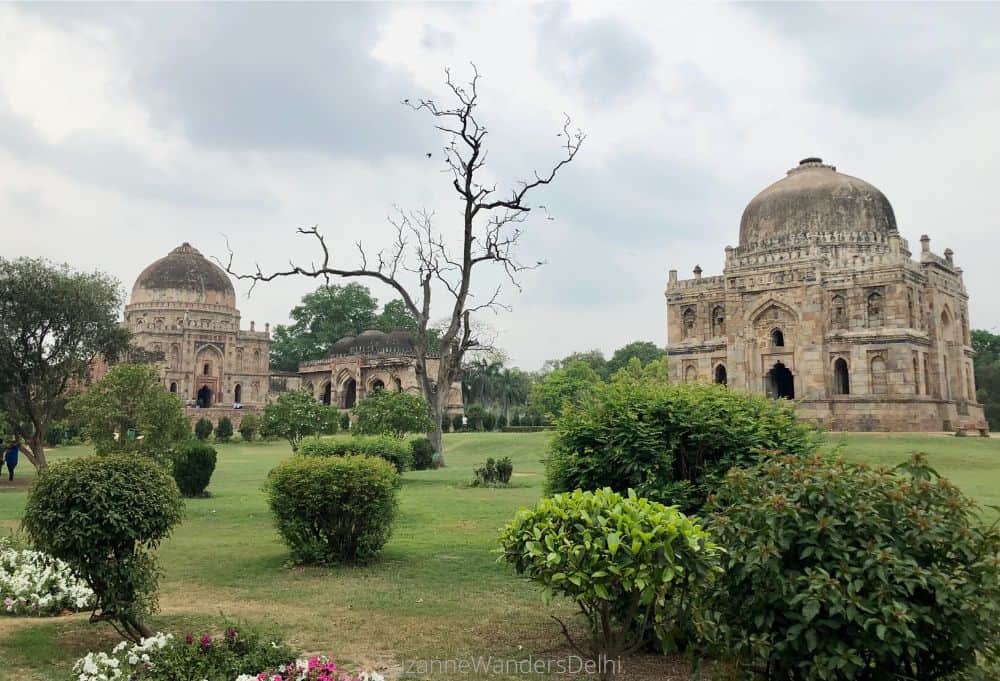
To reach Lodhi Garden from the Lodhi Art District, just walk up to Lodhi Road (or grab an auto-rickshaw depending on how far into the art murals you are) and the entrance to the park is right there.
- Hours & Admission: 6:00 am – 7:30 pm daily, free
- Nearest Metro station: Jorbagh (Yellow line) exit Gate 2
4. Khan Market
This is a favoured shopping district of expats and locals alike and the best market for first time visitors in Delhi. Khan Market is more upscale, with international brand stores like Kiehl’s and L’Occitane as well as Indian brands and designers such as Fabindia, Ranna Gill and Ritu Kumar. There are many coffee shops, bakeries, restaurants and a couple of Delhi’s top bookstores. It’s a great market for a ‘soft landing’ in Delhi.
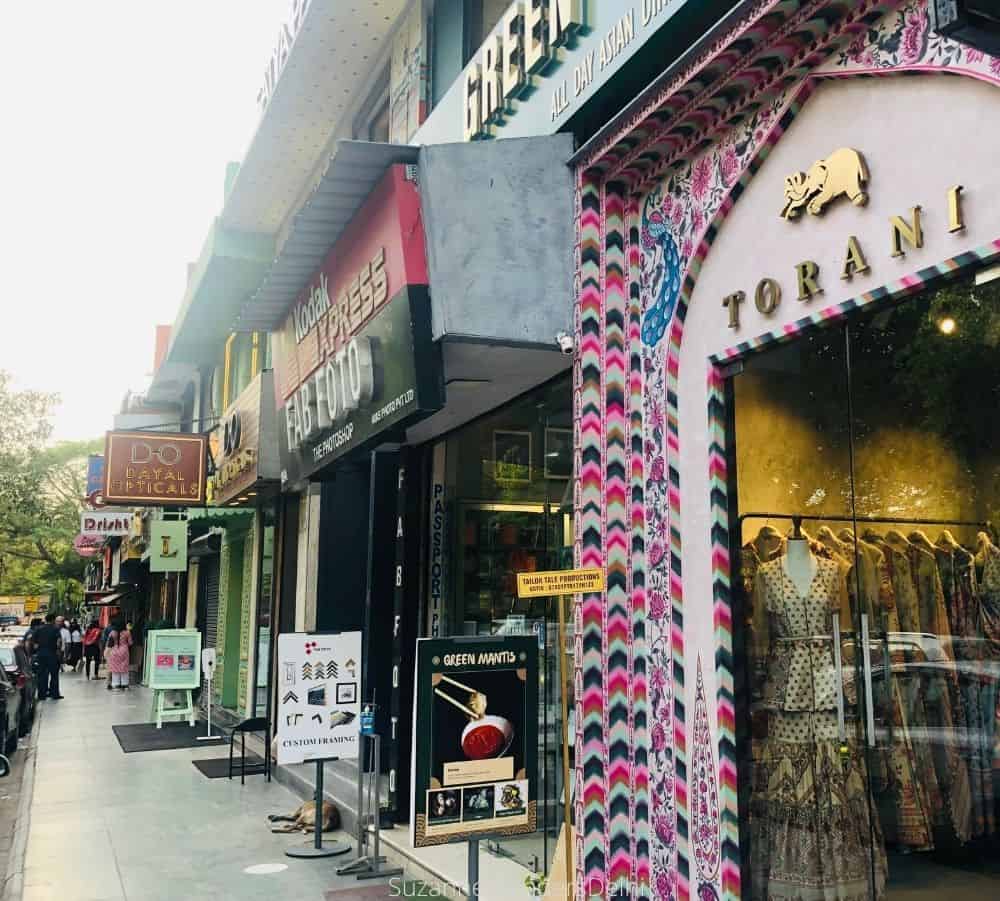
- Hours & Admission: 10:00 am – 10:00 pm (hours can vary depending on the shop) daily, free
- Nearest Metro station: Khan Market (Violet line) exit Gate 4
5. India Gate
End your day at one of Delhi’s most iconic sites, India Gate. India Gate is open all day, but it is particularly atmospheric after dark when it is lit up in the colours of the Indian flag. This is a favourite destination of locals and domestic tourists – it is always full of people, hawkers and food sellers.
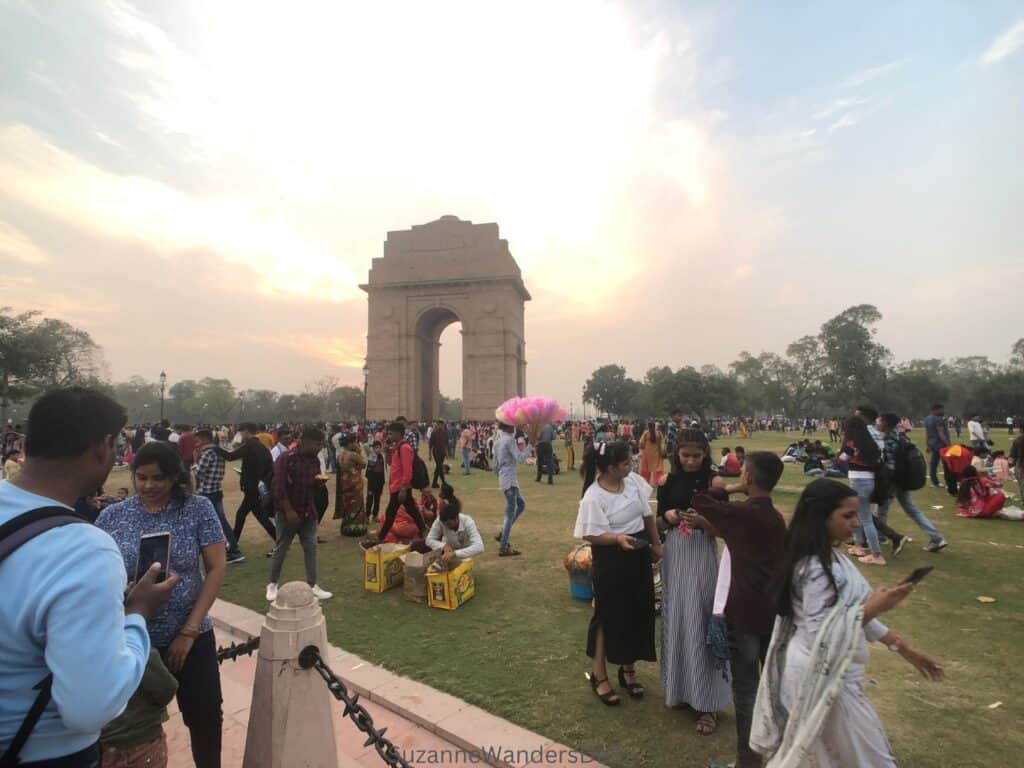
India Gate is a war memorial, dedicated to the soldiers who lost their lives in the WWI and the Anglo-Afghan war of 1919. An eternal flame burns day and night to remind the nation of the lives lost.
- Hours & Admission: 7:00 am – 11:00 pm daily, free
- Nearest Metro station: Central Secretariat (Yellow line) exit Gate 3
Where to Eat in Delhi on Day 1
Lodhi Art District (Lodhi Colony) & Lodhi Garden
- Jamun (modern Indian), Tres (upscale international) and one of Delhi’s most famous restaurants, Guppy (Japanese) are all really good restaurants on Block 13 of Lodhi Colony.
- Jaatre Ice Cream has fantastic artisanal ice cream with some interesting flavour combinations, served in a clay cup you can take home after. It’s located on Fifth Avenue.
- A couple of Delhi’s more unique eateries are in the India Habitat Centre, adjacent to Lodhi Colony: Habitat Hub (American themed diner) and Habiteria (premium food court).
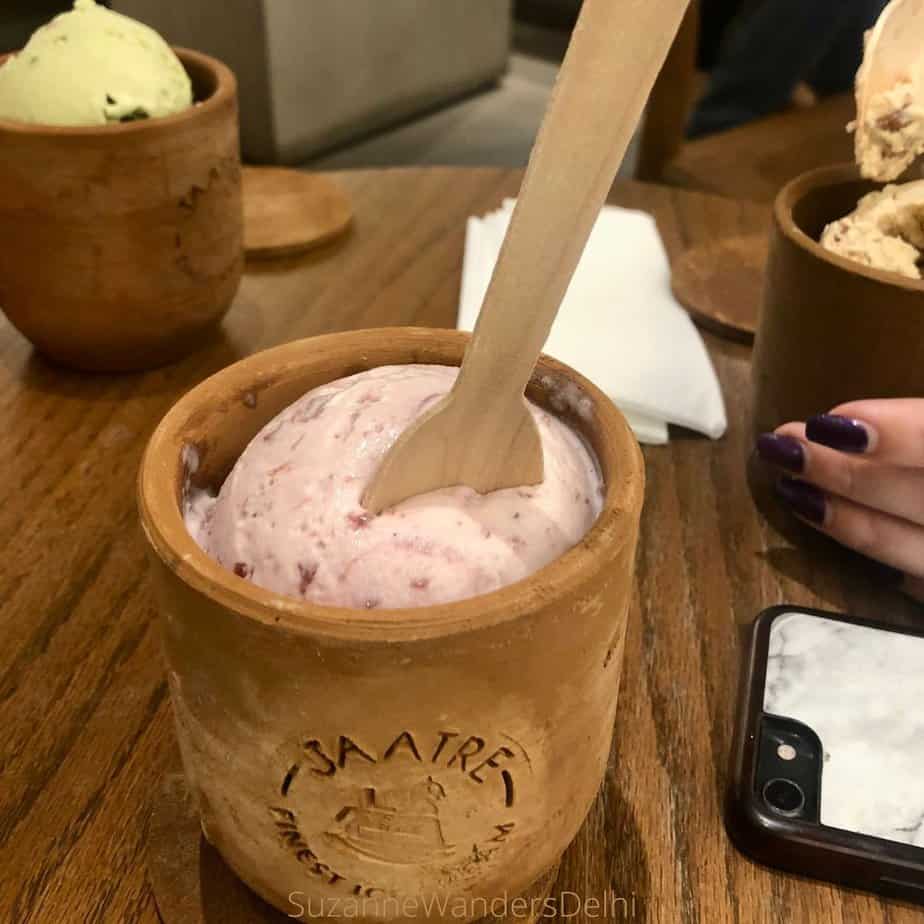
Khan Market
- Khan Chacha specialized in kathi rolls and biryani at very reasonable prices. They have a take-out stand in the middle of the market and a restaurant at the far end.
- Colocal serves milkshakes, good pasta and pizza, one has one of the best hot chocolates in Delhi
- Perch Wine & Coffee Bar is one of Delhi’s favourite cafes. Great coffee and food.
- The Big Chill Cafe has several locations in Delhi and they are always busy. On weekends there will be a wait. The menu is large, there’s something for everyone. If you’re looking for a quiet, intimate place, don’t go here.
- Punjab Grill is an upscale restaurant specializing in north Indian food. In winter they serve one of the tastiest sarson ka saag and makki ki roti in Delhi.
India Gate
- Gulati in Pandara Market has good Indian food. There are several other Indian restaurants in this plaza but Gulati is probably the best.
- Krishna Di Kulfi is a kulfi stand right beside Gulati in Pandara Market. This is one of the best places in Delhi for Indian style ice cream.
- Andhra Pradesh Bhavan is my favourite place to eat on a budget in Delhi. It’s a casual, state run canteen with an excellent vegetarian thali tray (non-veg is also available). You pay at the counter, sit down and servers come around and re-fill your tray as many times as you want. It’s located at 1 Ashoka Road.
Day 2: Hauz Khas Village, Deer Park, Shri Jagannath Mandir, Tombs of Green Park, Dilli Haat INA
Today is a fun mix of urban villages, historic, off-the beaten path monuments, an unusual South Indian temple and some shopping at one of Delhi’s best and most visitor friendly markets. These are all great sights if it’s your first time in Delhi.
1. Hauz Khas Village
Hauz Khas Village is a pedestrian friendly, trendy neighbourhood of winding lanes with shops, boutiques, restaurants and clubs. This is often the very first place I take my visitors, if it’s their first time to Delhi.
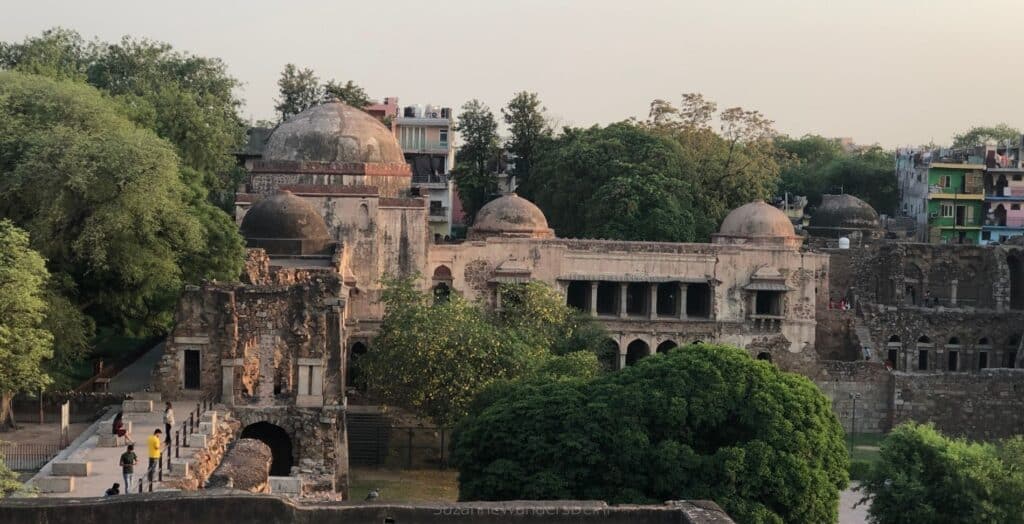
Hauz Khas Village is home to the spectacular Hauz Khas Fort, which was built in the 1300s as part of the second of Delhi’s historic cities, Siri. To reach the fort, continue down the main lane of Hauz Khas Village to the very end – that is the entrance to the fort.
If you go by metro, Hauz Khas Village is about a 25 minute walk. You can easily take a rickshaw from the metro to the Village entrance, but make sure you specify Hauz Khas Village, not just Hauz Khas, otherwise you’ll end up in a different area.
- Hours & Admission: 7:00 am – 7:00 pm (closed Sunday), INR 300 for foreigners (this is for the fort; the village is open 24/7 and there is no fee)
- Nearest Metro station: IIT (Magenta line) exit Gate 2 or Green Park (Yellow Line) exit Gate 4
2. Deer Park
Just outside the entrance to Hauz Khas Village is the entrance to Deer Park. Deer Park is a huge green space, part of Delhi’s green belt. There’s a nice walking path that goes around the reservoir of Hauz Khas Fort and the park is home to deer, rabbits and a number of birds.
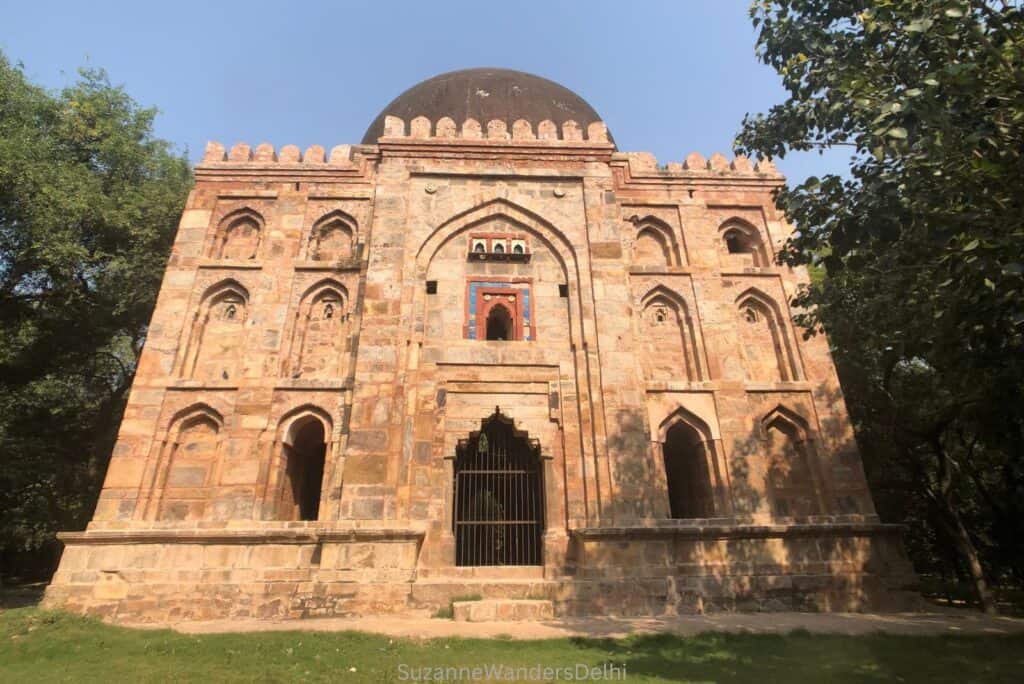
But the really special thing about Deer Park are the monuments from the Tughlaq and Lodhi periods: the Kali Gumti (built between 1320 and 1413), the Bagh i Alam Ka Gumbad (built in 1501), and several mosques.
- Hours & Admission: 5:00 am – 8:00 pm (summer) & 5:30 am – 7:00 pm (winter), free
- Nearest Metro station: IIT (Magenta line) exit Gate 2 or Green Park (Yellow Line) exit Gate 4
3. Shri Jagannath Mandir
If you exit Deer Park from the same entrance next to Hauz Khas Village, this small but well known south Indian temple will be just down the main road, about a 5 minute walk. Shri Jagannath Mandir is dedicated to the Hindu god Jagannath, who is an avatar of Vishnu and worshipped as a form of Lord Krishna in south India.
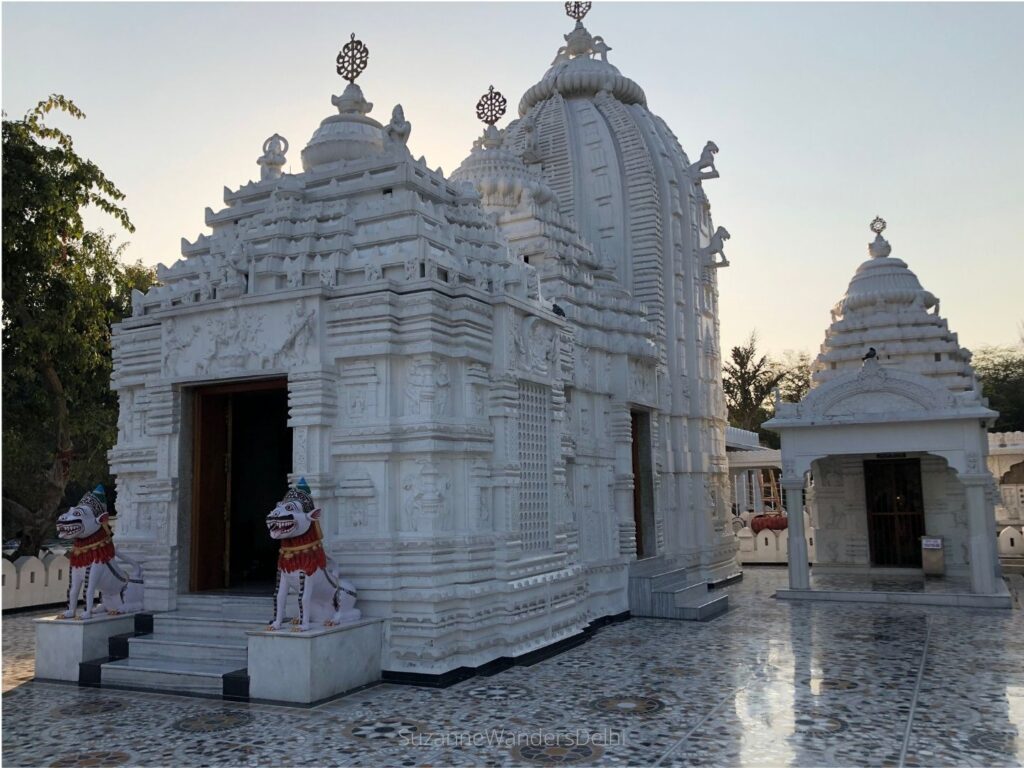
It’s a lovely complex, different in style from most of the temples in Delhi and usually quiet, making it a great temple for a first time visitor. Make sure you go inside the temples (there are several small ones) and check out the painted ceilings. Like in all temples, you must remove shoes before entering. There is a shoe minder just outside the entrance.
- Hours & Admission: 4:30 am – 1:30 pm & 4:00 pm – 10:00 pm (summer); 5:30 am – 1:30 pm & 4:00 pm – 9:00 pm (winter), free
- Nearest Metro station: Green Park (Yellow line) exit Gate 3
4. Tombs of Green Park
Green Park is one of Delhi’s more quiet and affluent neighbourhoods. Because of its location in the historic part of South Delhi, it is a virtual treasure trove of forgotten 15th century tombs. Even though the tombs are in a well populated area and close to Hauz Khas Village, which sees a lot of local and foreign traffic, most people don’t know they exist.
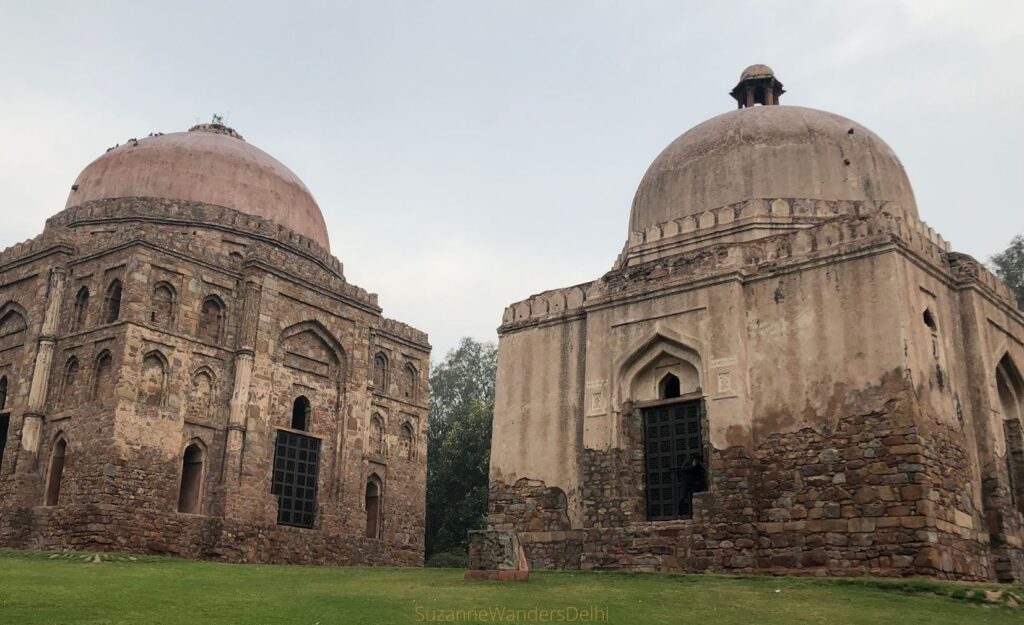
At one time this part of Delhi was dotted with the domes of tombs as far as the eye could see, but most have disappeared due to development. The Green Park tombs are in relatively good condition and free of encroachment.
There are 6 tombs in total (Dadi Poti Gumbad are two separate tombs, but next to each in the same location). They are all within walking distance of each other.
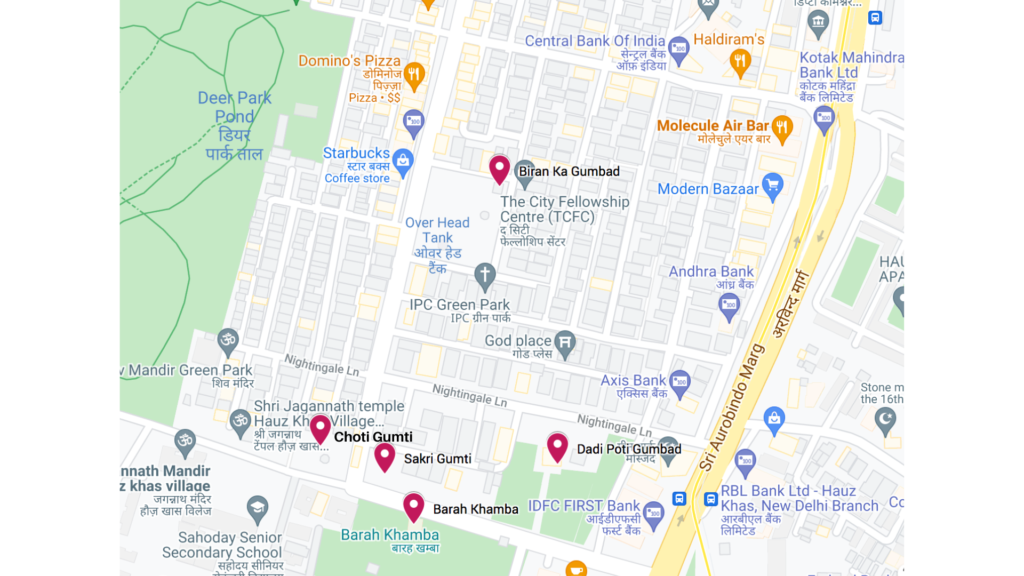
Green Park is an easy walk from the Shri Jagannath Mandir (about 12 minutes) or you can grab an auto- rickshaw; they’re always hanging out on the street there.
- Hours & Admission: 24/7 (except for the Dadi Poti Gumbad which has a full time guard and will be locked at night), free
- Nearest Metro station: Green Park (Yellow line) exit Gate 4
5. Dilli Haat INA
Dilli Haat is a pedestrian only, outdoor craft and food market. Artisans and craftspeople from all over India come here for two weeks at a time to sell their products. It’s an excellent place to shop for authentic handicrafts from around the country. There’s also a large food court offering foods from states all across India.
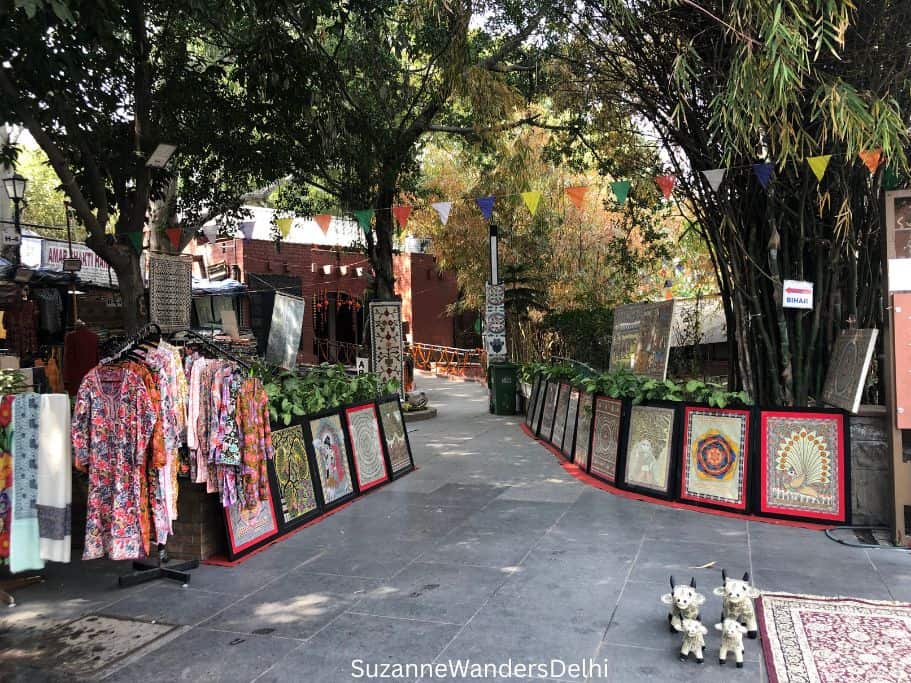
Prices may be slightly higher than in the local markets, but given the convenience of having everything in one place and being able to shop in a calm and traffic free environment, I think it’s worth it. Bargaining is absolutely fine, especially if you are purchasing more than one item.
To get here from Green Park, just hop back on the metro at the Green Park station and take it two stops to the Dilli Haat station. It’s also easy to reach by auto-rickshaw – just make sure the driver takes you to Dilli Haat INA, there are 3 Dilli Haat markets in Delhi. There is also a Delhi Haat INA shop in Saket – do not let your driver take you there!
- Hours & Admission: 10:30 am – 10:00 pm daily, INR 100
- Nearest Metro station: Dilli Haat INA (Yellow line) exit Gate 5
Where to Eat in Delhi on Day 2
Where to Eat in Hauz Khas Village
- Social is a casual, popular restaurant in the back lane of Hauz Khas Village. They have a great outdoor dining terrace with views of the fort.
- Naivedyam is an elegant south Indian restaurant and very popular.
- Elma’s Bakery & Kitchen is a popular cafe.
Where to Eat Near Deer Park
- Blue Tokai Coffee Roasters is probably Delhi’s best chain coffee shop that also serves food. There’s one across the street from the Humayun Pur Road side of Deer Park.
- The Piano Man Jazz Club is one of Delhi’s best jazz venues, but during the day it functions mainly as a restaurant.
Where to Eat Near the Green Park Tombs
- A2B and Evergreen Sweet House are both simple restaurants specializing in south Indian food. They’re located in the Green Park Market. Evergreen is also one of the best Indian sweet shops in Delhi.
- Veg Gulati is a nice Indian restaurant, a bit more expensive than A2B and Evergreen, but not overly so. They have a good lunch buffet.
Where to Eat in Dilli Haat INA
- the food court is great here – lots of options and reasonably clean.
Day 3: Agrasen ki Baoli, Jantar Mantar, Gurudwara Bangla Sahib, State Emporiums on Baba Kharak Singh Road, Connaught Place
Today is all about exploring the best of Central Delhi. Make sure you bring a dupatta or bandana with you, you’ll need one at Gurudwara Bangla Sahib.
1. Agrasen ki Baoli
Begin your day at one of Delhi’s most impressive under the radar sites. Agrasen ki Baoli is a very large, ancient stepwell with 108 steps and three arched levels. You’ll get some beautiful photos, it’s stunning. The current stepwell was rebuilt in the 14th Century by the Agrawal community, but the original dates back to 3000 BC. Some people believe the black water at the bottom of the well has mystical powers.

There’s some cool murals just outside the stepwell on Hailey Road and if you walk down the road a little you’ll see one of the best hidden gems of Delhi, Devi Prasad Sadan Dhobi Ghat, one of Delhi’s last remaining outdoor laundries.
- Hours & Admission: 7:00 am – 6:00 pm daily, free
- Nearest Metro station: Barakhamba Road (Blue line) exit Gate 4
2. Jantar Mantar
Jantar Mantar literally means “instruments for measuring the harmony of the heavens.” They are a group of 13 architectural astronomy instruments built in 1724 that were incredibly accurate. Now the fine calibrated markings on the instruments are severely eroded and in need of restoration. This particular jantar mantar is one of five built in India by the Maharaja Jai Singh II (today, four remain). The largest one is located in Jaipur.
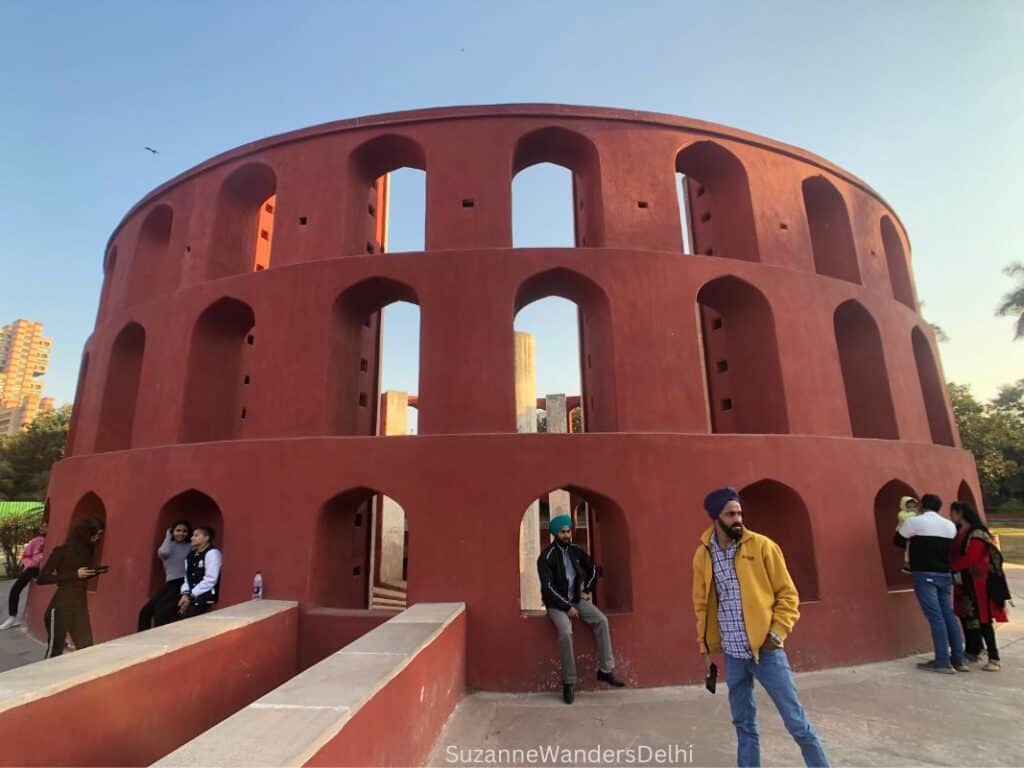
You can walk there from Agrasen ki Baoli, it’s straight across Tolstoy Road (about 15 minutes), or take an auto-rickshaw.
- Hours & Admission: 6:00 am – 6:00 pm daily, INR 300 foreigners, children under 15 free
- Nearest Metro station: Patel Chowk (Yellow line) exit Gates 1 or 2, or Janpath (Violet line) exit Gate 2
3. Gurudwara Bangla Sahib
Gurudwara Bangla Sahib is the most prominent gurudwara (Sikh temple) in Delhi for the Sikh community. It’s actually a whole complex, comprising of the temple, two langar halls, a museum, offices, hospital and accommodation for pilgrims. It’s a beautiful site and people of all different religions, races and nationalities are welcome.
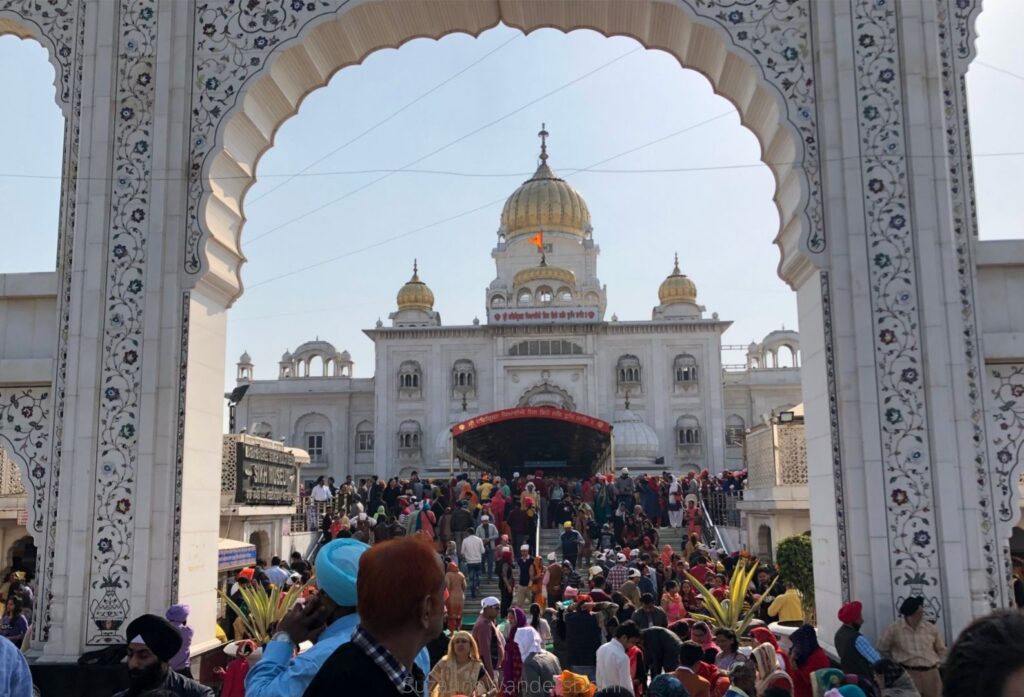
There are lots of things to do at Gurudwara Bangla Sahib, but the two most important (besides visiting the temple) are circumventing the Sarovar (holy pool) and having langar in the dining hall. Here’s how to eat langar at a gurudwara.
Langar is the free vegetarian meal prepared by volunteers. It’s a wonderful community experience and everyone is welcome. Gurudwara Bangla Sahib feeds 300 people every 15 minutes. Everyone sits together on the floor in rows while volunteers walk up and down the aisles filling trays with vegetarian food. Eat as much as you want, but the food is considered blessed so don’t leave any food on your tray.
Men and women must cover their heads on entering a gurudwara. Bangla Sahib has a visitors centre with bandanas but there are also several bins of bandanas in the courtyard available for borrowing. You must remove your shoes and leave them in one of the shoe storage areas before entering the temple.
- Hours & Admission: 24/7, free
- Nearest Metro station: Shivaji Stadium (Orange line) exit Gate 1
4. State Emporiums on Baba Kharak Singh Road
If you want to learn about the culture and shop for handicrafts from all across India, the shops of Baba Kharak Singh Road are the place to come.

The emporiums are state-run shops which sell local handicrafts and products. There are 4 blocks of these on Baba Kharak Singh Road, conveniently located on one side of the street very close to Connaught Place, and they’re ideal for a first time visit to Delhi. Prices are usually reasonable (except for the Delhi emporium, which I find over-priced).
You can buy tea from Assam, hand-made carpets and real pashminas from Kashmir, cotton and silk shawls from Bihar, Gujarati wood carvings, Rajasthani paintings, huge sandstone carvings from Odisha, pearls from Telangana, brass deities from Tamil Nadu, traditional saris from Kerala and warm sweaters and socks from Himachal – all in one afternoon!
From Gurudwara Bangla Sahib, walk straight up Baba Kharak Singh Road. The shops start just opposite the Shivaji Stadium metro station.
- Hours & Admission: 10:00 or 10:30 am – 6:30 or 7:00 pm Monday to Saturday (closed Sunday), free
- Nearest Metro station: Rajiv Chowk (Yellow or Blue lines) exit Gate 7 or Shivaji Stadium (Orange line) exit Gate 1
5. Connaught Place
Continue walking straight up Baba Kharak Singh Road to the inner circle of Connaught Place. This is the British built commercial and shopping hub of Delhi and its unofficial centre. It’s a favourite meeting and hang-out spot for visitors and locals.
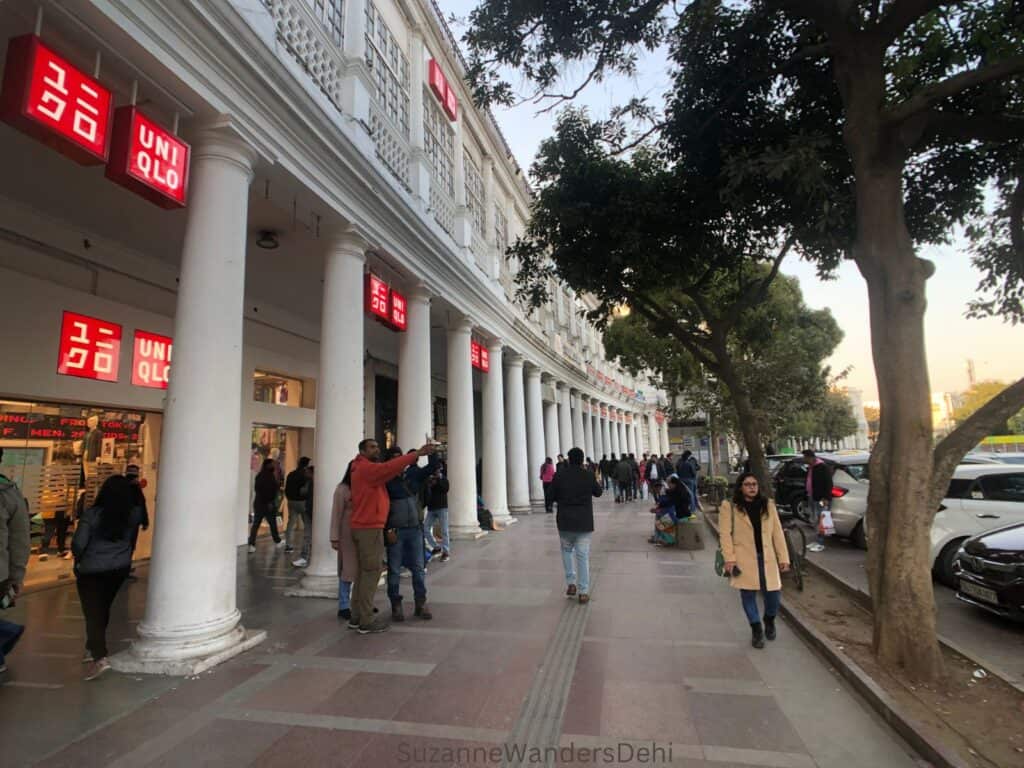
Everything is at Connaught Place (locally known as CP): art galleries, international and Indian brand stores, tech stores, restaurants, money exchanges, book shops, movie theatres, bazaars, clubs and bars, street vendors, even a Museum of Illusions. CP is designed as three concentric traffic and commercial circles, all in colonnaded, Georgian style buildings that are easy to navigate and offer shade.
Don’t miss the Charkha Museum with its 26 foot charkha and the Khadi store on the outer circle which sells very reasonably priced homespun textiles, food and ayurvedic products. There is also an underground bazaar, Palika Bazaar.
- Hours & Admission: 10:00 am – 8:30 to 10:00 pm (can vary), free
- Nearest Metro station: Rajiv Chowk (Yellow or Blue lines) exit Gates 2, 3, 4 or 5
Where to Eat in Delhi on Day 3
Where to Eat Near Agrasen ki Baoli
- The Tin Cafe at the British Council is excellent though you will have to show ID and go through security to get into the British Council building. It’s on KG Marg, toward Connaught Place.
- Saravana Bhavan on Janpath Road has good south Indian food.
- Kake da Hotel on Connaught Circle is a very famous and local (casual) eatery specializing in north Indian food. Food is delicious but on the spicy side.
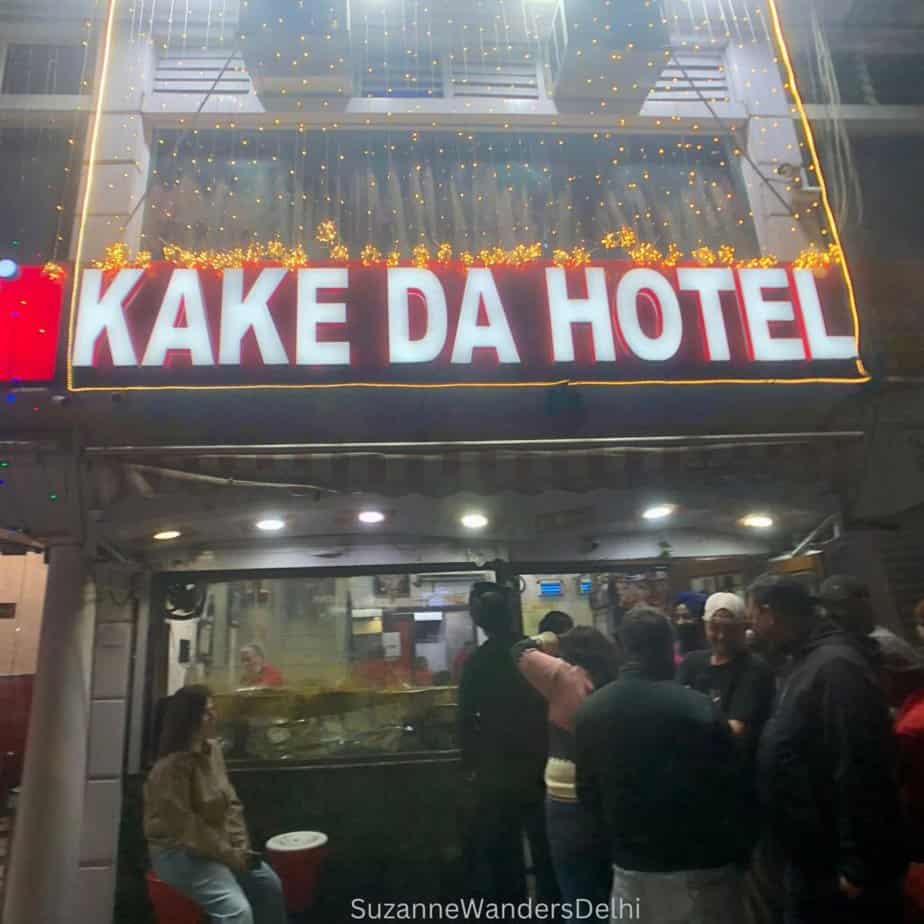
Where to Eat Near Jantar Mantar
- The Atrium or 1911 Restaurant in the Imperial Hotel, one of Connaught Place’s best hotels. Both are both lovely and sedate.
Where to Eat at Gurudwara Bangla Sahib
- langar in one of the two langar halls.
Where to Eat Near the State Emporiums on Baba Kharak Singh Road
- Coffee Home is a decent cafeteria style restaurant which specializes in south Indian food. It’s between the Maharashtra and Assam emporiums. They serve good dosa and filtered coffee and have a large outdoor terrace.
Where to Eat in Connaught Place
- United Coffee House is an oasis of vintage luxury on Block E of Connaught Place. They specialize in Indian and international cuisine.
- Zaffran is a mid-priced restaurant with great food located in Hotel Palace Heights, Block D.
- Haldiram’s on Block L is a budget friendly eatery.
- Social on Block A, a popular and casual restaurant which serves Indian and international food.
- Kake da Hotel on Connaught Circle (the outer circle) is a very famous and local eatery specializing in north Indian food. Food is delicious but on the spicy side.
- Pind Balluchi is a comfortable restaurant specializing in north Indian cuisine. There are two locations in Connaught Place, one in the Regal Building and one in Scindia House.
Day 4: Qutab Minar, Mehruali Archeological Park, Bahai Lotus Temple, Central Market Lajpat Nagar
Today you’ll see one of India’s most famous UNESCO sites, get way off the beaten path in Mehruali, visit one of the most famous temples in the world, and finish the day at one of Delhi’s best local markets.
1. Qutab Minar (UNESCO)
Begin your day at this lovely UNESCO site, the Qutab Minar. If it’s your first time in Delhi, this site is an absolute must. It is the tallest brick minaret in the world and tallest minaret in India. It is considered a wonderful example of Indo-Islamic-Afghan architecture, dating back to 1192. The Qutab Minar is part of a larger complex, and you can walk through the peaceful park and ruins of a mosque, madrasa, tombs, see another minar and the famous iron pillar that has never rusted.
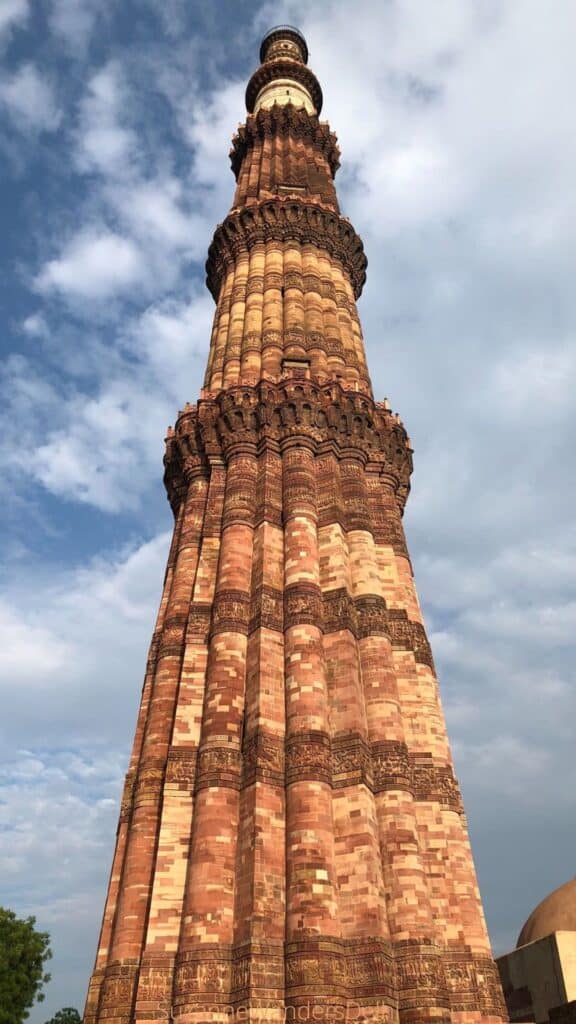
Make sure you queue in the correct line to buy tickets. The foreigner line is usually much shorter.
- Hours & Admission: 7:00 am – 9:00 daily, INR 600 for foreigners, children under 15 free
- Nearest Metro station: Qutab Minar (Yellow line) exit Gates 1 or 2
2. Mehrauli Archeological Park
Mehrauli Archeological Park just underwent a major restoration, and I was blown away by the transformation (which is often not the case with Delhi’s historic monuments are ‘restored’). It’s almost unrecongizable from the inhospitable, scrubby forest it used to be.
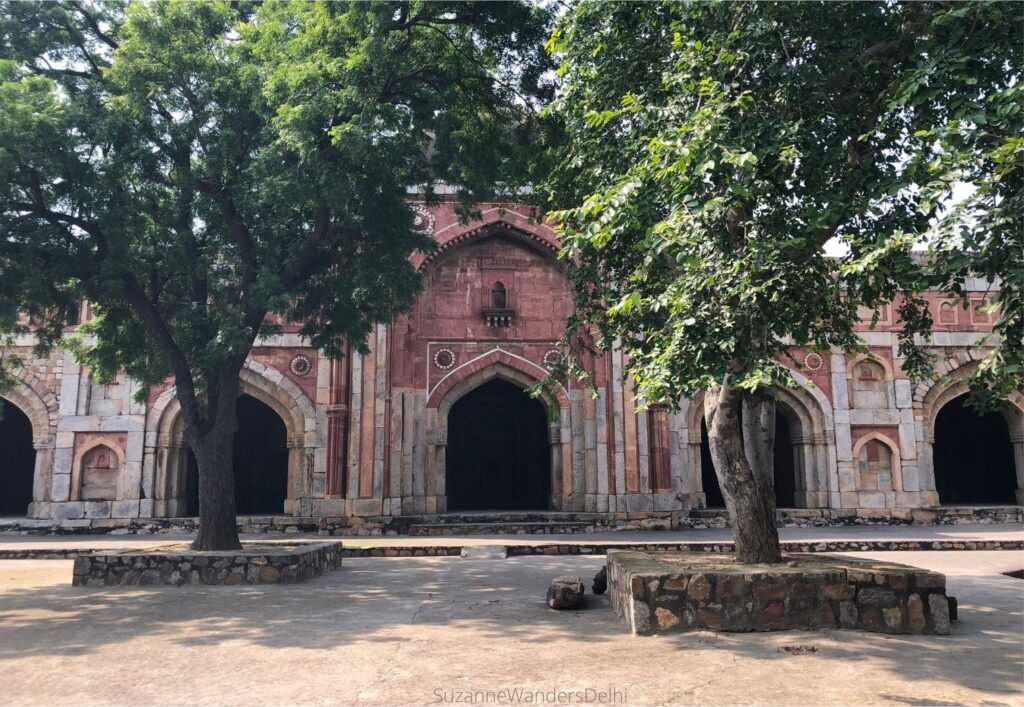
This was one of the most underrated and least visited sites in Delhi, but I don’t think it will stay that way much longer.
Visitors can stroll through gardens, forest, up and down walkways leading to historical monuments from the pre-Isalmic to late Mughal periods. Several monuments that were closed to the public are open now, as well as a large area of ruins.
The Mehrauli Archeological Park monuments are amazing, especially the Rajon ki Baoli, Jamali Kamali mosque and tomb of Quli Khan.
After leaving the Qutab Minar, just walk down the road about 300 metres to the entrance for the Archeological Park.
The park abuts the urban village of Mehrauli which also has some incredible, but mostly unprotected Mughal ruins. The Jahaz Mahal is particularly spectacular.
- Hours & Admission: 7:00 am – 7:00 pm, daily; INR 500 for foreigners
- Nearest Metro station: Qutab Minar (Yellow line) exit Gates 1 or 2
3. Bahai Lotus Temple
This beautiful temple resembles a lotus flower and is built entirely of white marble. It is one of the most visited religious buildings in the world, and has won many awards for its architecture. Currently it is on the UNESCO World Heritage tentative list.
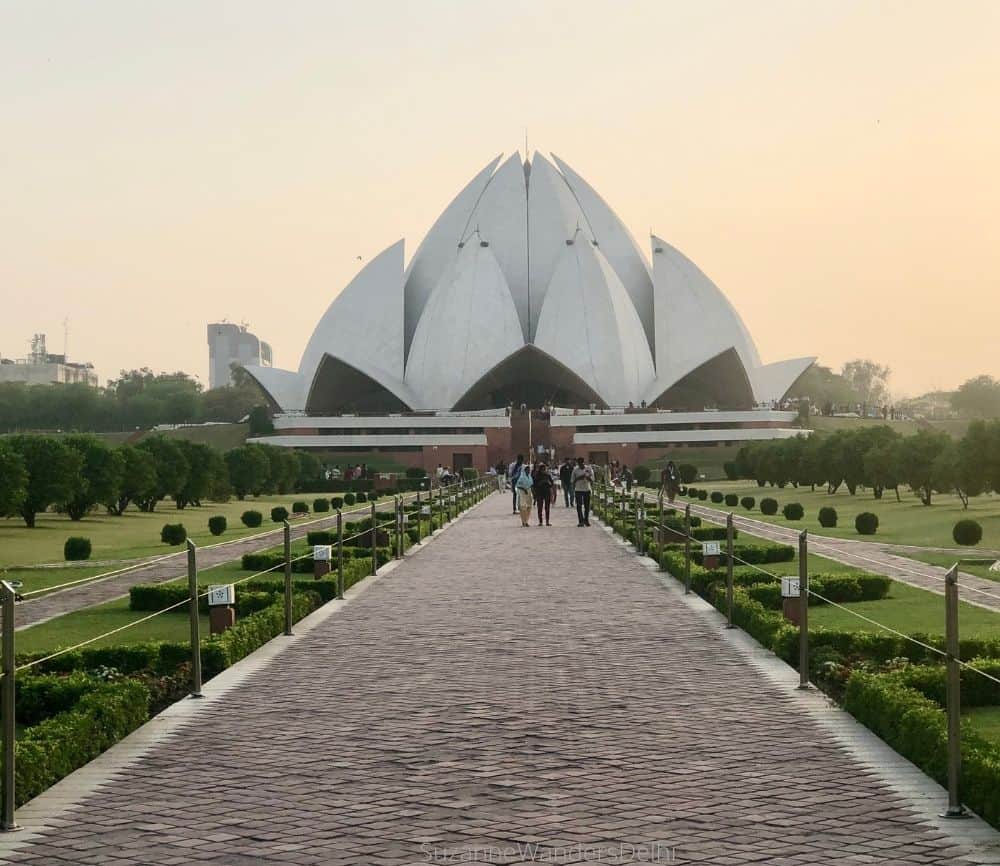
The Bahai Lotus Temple exudes a calm, peaceful ambiance and all faiths are welcome. It gets busy on weekends and holidays; the lineup can take an hour. You will need to remove your shoes before entering the temple and place them in the bags provided.
To reach the Bahai Lotus Temple from Mehrauli, take an Uber or the metro.
- Hours & Admission: 8:30 am – 5:00 pm (closed Monday), free
- Nearest Metro station: Kalkaji Mandir (Violet or Magenta lines) exit Gates 1 or 2 or Okhla NSIC (Violet line) exit Gate 2
4. Central Market Lajpat Nagar
This is the favoured market of Delhiites wanting to shop for traditional clothing on a budget. All my Delhi girlfriends shop here, and it’s the first place they mention when I ask where to get desi (Indian) clothing. It’s also extremely well known for its street food, and there are some fabulous stalls here.
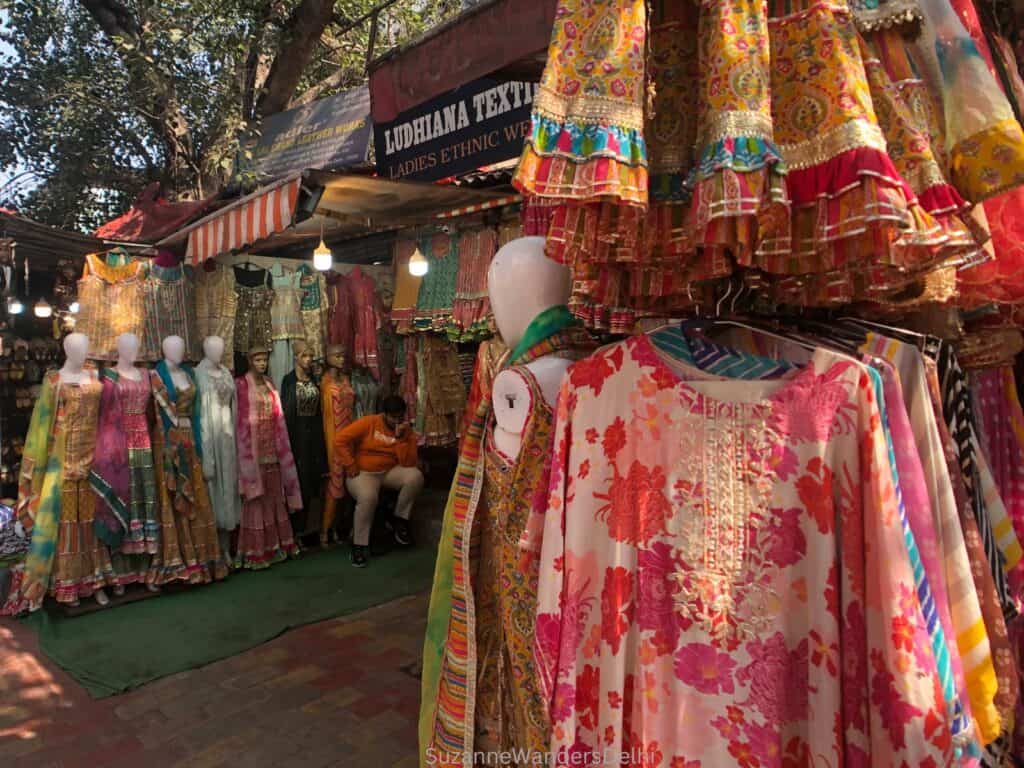
Even if you don’t want to shop, it’s a fun market to walk around and it’s pedestrian friendly. Try the street food while you’re here but read my tips on how to eat street food safely and eat at one of the places listed below.
The shops located around the periphery of the market are more expensive – this is where a number of jewellers are located. You’ll see some beautiful items in these shops, especially spectacular Indian-style jewellery.
To reach Central Market Lajpat Nagar from the Bahai Lotus Temple, either hop back on the metro at the Kalkaji Mandir metro station and take the Violet line to Lajpat Nagar station, or take an auto-rickshaw. They are always waiting around outside the main entrance at the Bahai Lotus Temple.
- Hours & Admission: 11:00 am – 9:00 pm (closed Monday), free
- Nearest Metro station: Lajpat Nagar (Violet and Pink lines) exit Gate 5
Where to Eat in Delhi on Day 4
Where to Eat Near Qutab Minar and Mehrauli Archeological Park
- The Grammar Room is one of Delhi’s nicest cafes, just behind the Qutab complex on Kalka Das Marg. They open at 11:00 am.
- CHO is an excellent Vietnamese restaurant about 5 minutes walk from the Qutub complex in Ambawatta One
- Cafe Stone in the Mehrauli Archeological Park – I’ve never eaten there so I can’t vouch for the food, but it’s located in a historic round house.
Where to Eat Near the Lotus Temple
- Epicuria Food Mall is located at the Nehru Place metro station. There are many restaurants, cafes and a food court here.
Where to Eat in Central Market Lajpat Nagar (and what to eat)
- Ram Laddu Food Corner – ram laddu
- Vinod Snacks – kachori aloo sabzi
- Dolma Aunty Momo’s – momos
- Jhakkas Bombay Pav Bahji – pav bhaji dabeli
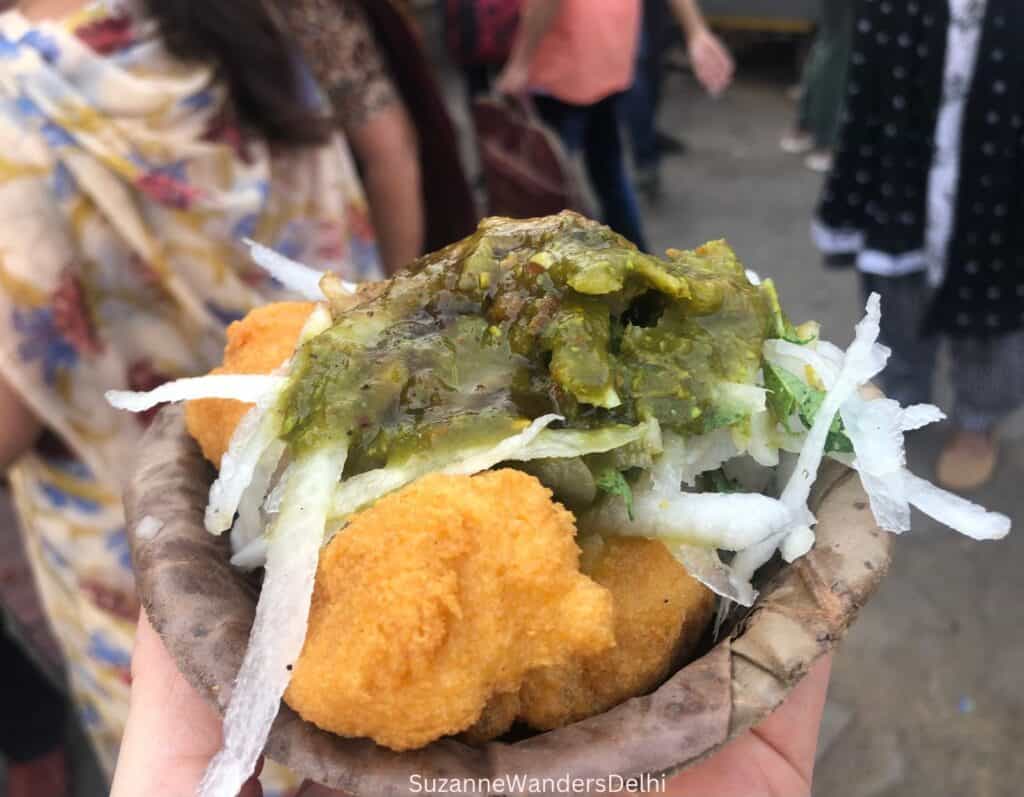
Day 5: Red Fort, Chandni Chowk, Khari Baoli, Jama Masjid, Raj Ghat (Gandhi Memorial)
Hopefully by now you are somewhat acclimatized to Delhi; that is why I have saved Old Delhi for the last day. Historically it is the most important part of Delhi, but it’s bonkers. It was primarily build by Shah Jahan (who built the Taj Mahal) in the 1600s and is the last of Delhi’s 7 historic cities.
1. Red Fort (UNESCO)
One of the most magnificent sites in Delhi, the Red Fort, also called Lal Quila, was built by Shah Jahan (the same ruler who built the Taj Mahal) in 1639. It remained the main residence of all successive Mughal rulers until the British imprisoned and then ousted the last Mughal ruler in 1857.

The Red Fort was a world in itself with beautiful gardens, marble audience halls, palaces, baths and its own covered bazaar so that the women did not need to leave the safety of the fort. Hundreds of people resided and worked within its confines.
You can purchase tickets at the fort but make sure you get in the correct line. There is a separate line and price for foreigners. The ticket booth is near Delhi Gate.
- Hours & Admission: 8:00 am – 9:00 pm (closed Monday), INR 600 for foreigners, children under 15 free
- Nearest Metro station: Lal Quila (Violet line) exit Gate 4
👍 If you are visiting around August 15th (Independence Day) check ahead because the Red Fort usually closes to visitors about 10 days before. The Prime Minister addresses the nation from the fort on Independence Day and it is closed for preparations.
2. Chandni Chowk
Chandni Chowk is the name of main street that runs between the Red Fort and Fatehpuri Masjid; it is also the name used for this part of Old Delhi. You could easily spend an entire day here, but I’ll give you the highlights. If you’ve ever seen the iconic images of Delhi with congested narrow streets and a tangle of overhead electric wires, it was here.
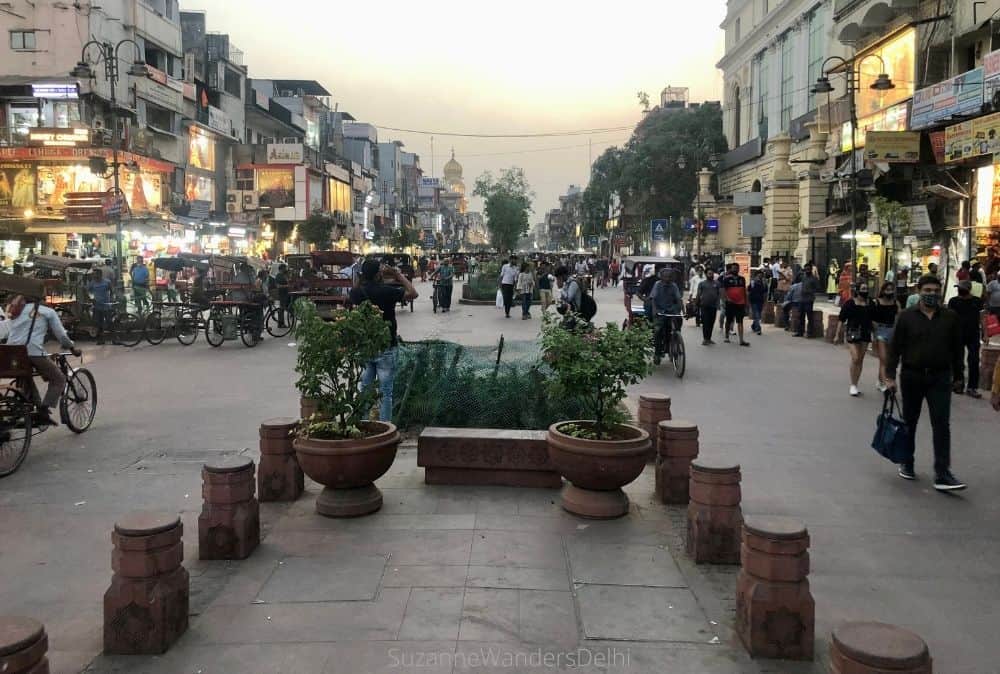
After exiting the Red Fort, start walking up Chandni Chowk Road, which is now a pedestrian friendly heritage zone during the day. The road is full of important and historic sites:
- Shri Dimambar Jain Lal Mandir – the Jain temple with a famous bird hospital
- Kinari Bazaar (off Dariba Kalan Road) – the famous wedding and trim market
- Gurudwara Sis Ganj Sahib – stunning Sikh gurudwara
- Paranthe Wali Gali – the famous lane filled with parantha shops (traditional flat bread)
- Fatehpuri Masjid – located at the end of Chandni Chowk Road, it is the mosque built for Fatehpuri Begum in 1650, one of Shah Jahan’s wives
I usually don’t recommend guided tours, but this is one area where it would be helpful, especially if it’s your first time in Delhi. Both Delhi Heritage Walks and India City Walks offer heritage walking tours which give you the highlights and include sampling street food.
- Hours & Admission: 24/7 but avoid late at night (markets are closed Sunday), free
- Nearest Metro station: Chandni Chowk (Yellow line) exit Gate 5
3. Khari Baoli
This market is on many tour itineraries and is the most well known of the Old Delhi markets. Khari Baoli is Asia’s largest wholesale spice bazaar and exploring it will be an adventure for your olfactory senses and make for colourful pictures.
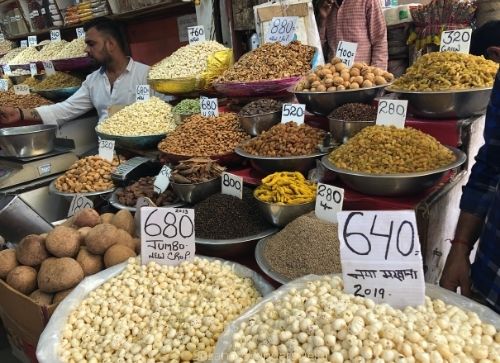
Shops on the main market road cater to tourists with convenient pre-packaged spices, teas, dried fruit and nuts. Prices in these shops tend to be higher than in local neigbourhood markets, but if you’re willing to explore the side and back lanes, there are smaller vendors with better prices who are more open to bargaining.
It’s located just around the corner from Fatehpuri Masjid, just a few minutes walk.
- Hours & Admission: 11:30 am – 6:00 pm (closed Sunday), free
- Nearest Metro station: Chandni Chowk (Yellow line) exit Gate 1
4. Jama Masjid
This is the largest mosque in Delhi, built by Shah Jahan (the ruler who built the Taj Mahal) in the 1650s. It was the personal mosque for himself and the royal family. Every day Shah Jahan would walk to the Jama Masjid from the Red Fort. It is a beautiful structure with three gates, four towers and two minarets, all of red sandstone and marble that can accommodate 25,000 worshipers at one time.
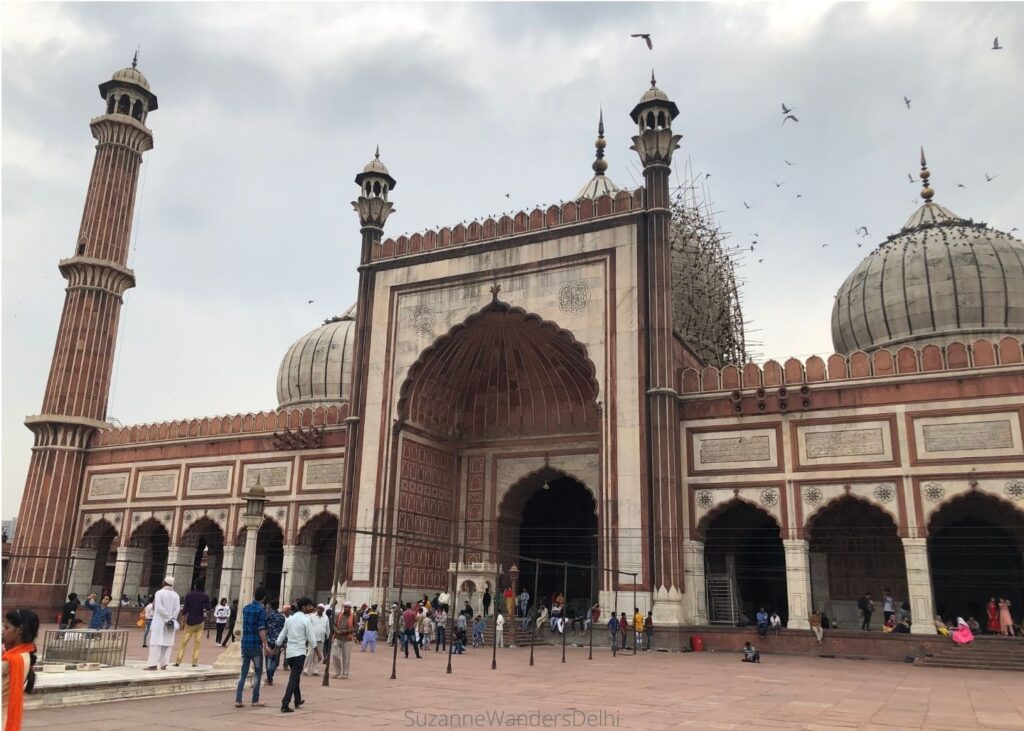
The Jama Masjid is a working mosque – visitor hours are restricted to allow for prayer times. Both men and women should cover arms and legs, and women must also cover their heads. There are sarongs at the front entrance if your outfit is unsuitable. Most visitors end up having to put on a sarong, even men. I’ve only managed to get away with my own outfit once or twice and I’ve been numerous times.
Shoes must be removed before entering the mosque. Either carry them discreetly or leave them with the shoe minder who will expect a small tip.
👍 Jama Masjid is a common name for a mosque, it means Friday Mosque. There are several Jama Masjids in Delhi. If you are not coming here directly from Khari Baoli, make sure you specify the Jama Masjid in Old Delhi.
- Hours & Admission: 7:00 am – 12:00 pm and 1:30 pm – 6:30 pm (Friday will be especially busy, the day of worship in the Islamic faith), free but there is a INR 300 fee for bringing a camera in
- Nearest Metro station: Jama Masjid (Violet line) exit Gate 2
5. Raj Ghat (Gandhi Memorial)
Mahatma Gandhi is a venerated figure across India, considered the father of the nation. His birthday, October 2nd, is a national holiday, his face is on the currency and his portrait still hangs in government offices. Raj Ghat is where Gandhi’s last rites were performed, the day after his assassination on January 30, 1948. The memorial itself is simple – a black marble platform with an eternal flame, meant to reflect the simplicity of Gandhi’s life.
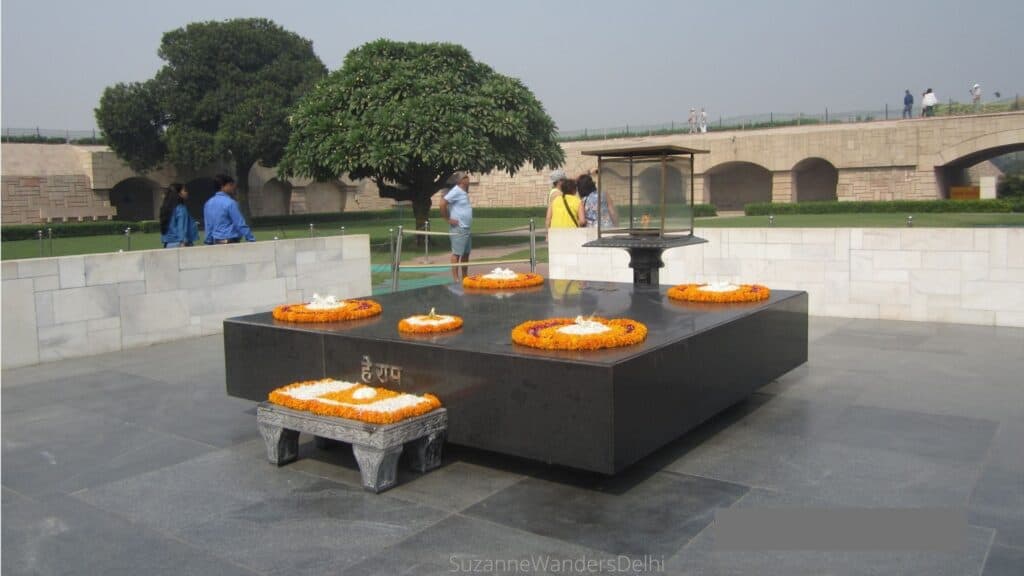
There are two other Gandhi sites in the immediate area: Gandhi Darshan is a park with an exhibition based on Gandhi’s life. It is directly across the street. The National Gandhi Museum and Library is kitty corner to Raj Ghat. Both sites are free.
Shoes must be removed and place in the storage area before entering the memorial.
- Hours & Admission: 6:30 am – 6:00 pm, free
- Nearest Metro station: Delhi Gate (Pink line) exit Gate 4
Where to Eat in Delhi on Day 5
Where to Eat in the Red Fort
- Cafe Delhi Heights and Jugmug Thela are located right in the Red Fort.
Where to Eat at Chandni Chowk and Khari Baoli
- Haldiram’s on Chandni Chowk – a casual and usually very clean restaurant for many Indian snack foods and small meals (this location is not always as clean as other Haldiram’s).
- Asha Ram across the road from Town Hall. They are famous for their paranthas and have been there for 90 years.
- Gurudwara Sis Ganj Sahib for langar, the free community meal.
- Shri Hari Sharnam is a simple restaurant very near Fatehpuri Masjid.
- Kake Di Hatti is a simple but wonderful eatery specializing in north Indian food, located very close to Fatehpuri Masjid.
Where to Eat Near Jama Masjid
- Karim’s Hotel and Aslam Chicken are both well known local places. They are on Matia Mahal Road which is directly opposite Gate 1 of the Jama Masjid.
- Cool Point is halfway between Karim’s Hotel and Aslam Chicken and serves a very traditional Delhi dessert, shahi tudka out of big vats on the street.
- Ebony Cafe is at the corner of Patel Gali Road and Jama Masjid Road near Gate 3 of the Jama Masjid. It’s a great cafe with non-Indian options which opens at 3:00 pm
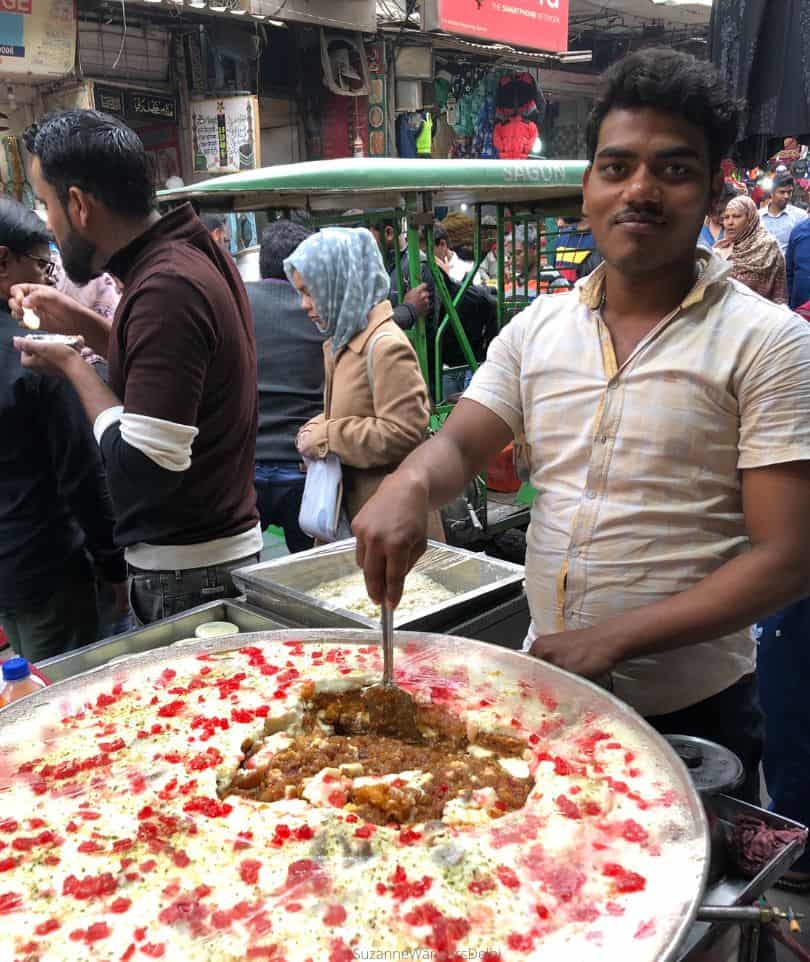
Where to Eat Near Raj Ghat
- Udupi Cafe on Maharao Krishna Marg – they specialize in South Indian food. You can reach there by walking or taking an auto rickshaw.
More Things To Do if It’s Your First Time in Delhi
1. Visit Humayun’s Tomb (UNESCO)
This was the first garden tomb in India and the first to use red sandstone on such an immense scale. It’s a beautiful example of Mughal architecture and a UNESCO world heritage site. The complex has several well preserved and lovely tombs, Persian gardens and the graves of 150 Mughal royals and their entourage.
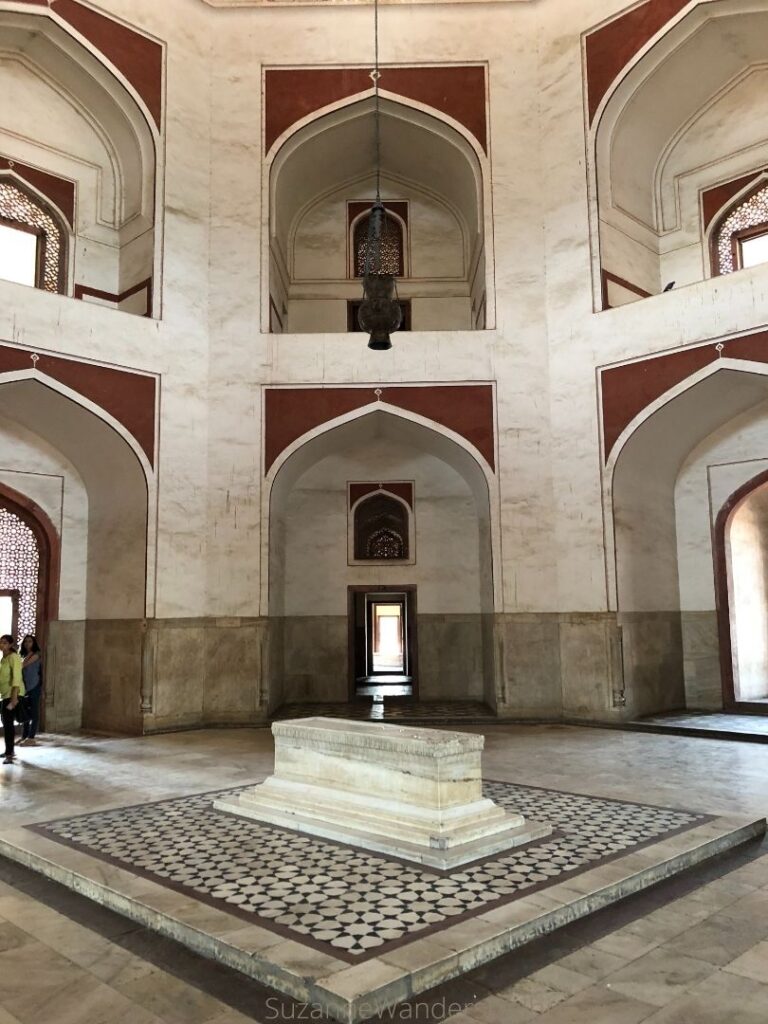
Since being built in 1572 the tomb has been refuge to the last Mughal ruler of Delhi from the British during the Rebellion (or the Mutiny as the British call it) in 1857, and a refugee camp for Muslims fleeing to Pakistan during Partition in 1947.
- Hours & Admission: 8:00 am – 6:00 pm, INR 600 for foreigners, children under 15 free
- Nearest Metro station: Jawaharlal Nehru Stadium (Violet line) exit Gates 2 or 3
2. See one of the World’s Largest Hindu Temples, Swaminarayan Akshardham
Akshardham Temple is a stunning masterpiece of intricately carved marble from floor to vaulted ceiling. It is some of the most breathtaking architecture I have ever seen in India. It’s built entirely of Italian Carrara marble and Rajasthani pink sandstone, without structural steel.
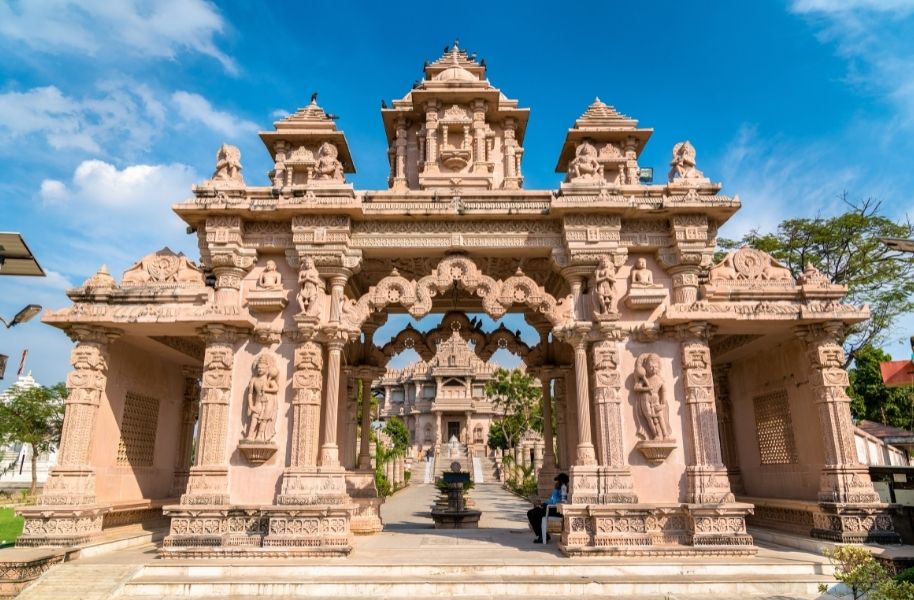
The temple is one of the largest Hindu temples in the world. It was completed in 2005 after only 5 years of construction, due mostly to the tireless devotion of 7,000 artisans and the 3,000 volunteers who assisted them.
There is a strict dress code at the temple. Shoulders, chest and upper arms must be covered and bottoms must be below the knee. Sarongs are available to borrow for a small refundable deposit.
- Hours & Admission: 10:00 am – 7:00 pm (closed Monday), free except for the special exhibits
- Nearest Metro station: Akshardham (Blue line) exit Gate 1
3. Eat Street Food
One of the best ways to experience Delhi is through its food. The city has a vibrant and plentiful street food scene, and stalls are everywhere. The most delicious food I have ever had in Delhi has been on the streets.
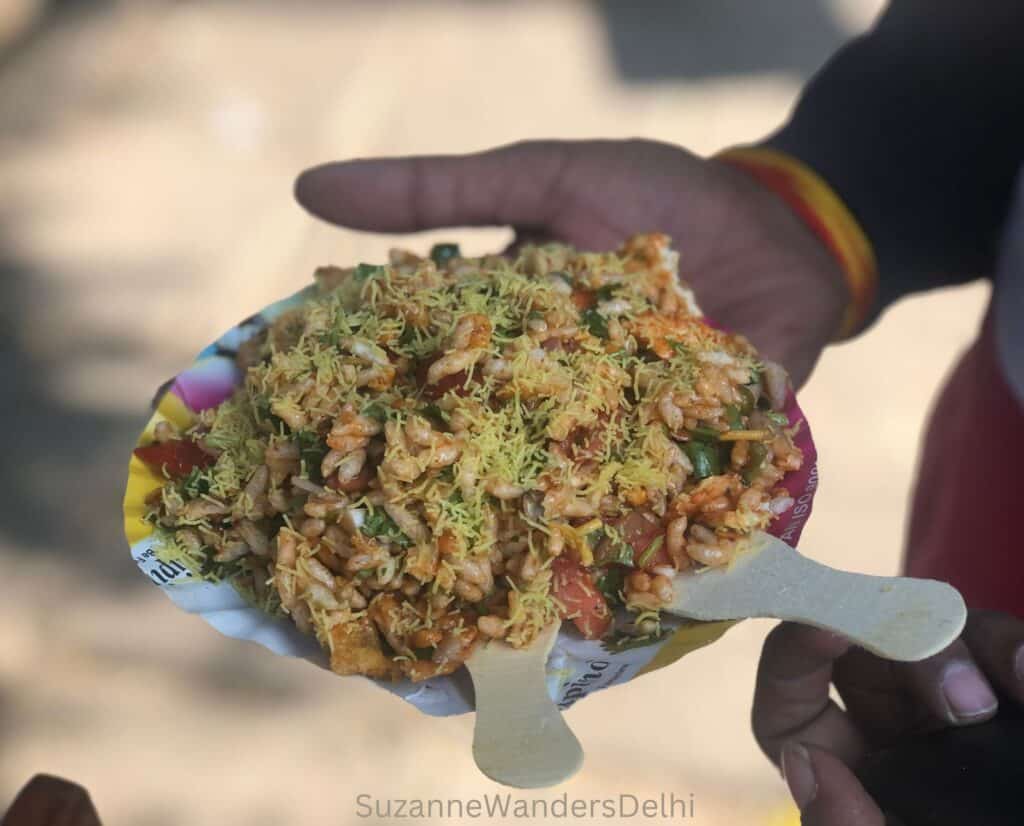
Of course, you do need to exercise some caution so you avoid the dreaded Delhi Belly (but watch the movie of the same name, it is hilarious and mostly in English). Read my tips on how to eat local and stay healthy.
Central Market Lajpat Nagar, Amar Colony Market and Connaught Place are 3 wonderful markets for street food that aren’t in Old Delhi.
If you want to do your own street food walk of Old Delhi, here’s my personal DIY street food tour itinerary.
4. See a Bollywood Movie
Indians love their movies and are a very enthusiastic audience. Seeing a Bollywood movie is really an iconic experience that every first time visitor in Delhi should do. Bollywood produces over 1,000 movies per year, double that of Hollywood. Some have English subtitles (the movie listings will indicate if they are subtitled) but even if not, don’t let that stop you, the plots are often simple and fairly easy to follow.
There are great movie theatres all over Delhi and you can check for current listings at:
5. Get Cultural at the India Habitat Centre
This is Delhi’s cultural centre, it’s a whole complex devoted to promoting Indian art in all its forms. There are always free visual arts exhibitions open to the public, and the Stein Auditorium hosts a variety of performing arts including film screenings, theatre, dance and music performances. Check out the schedule of events at:
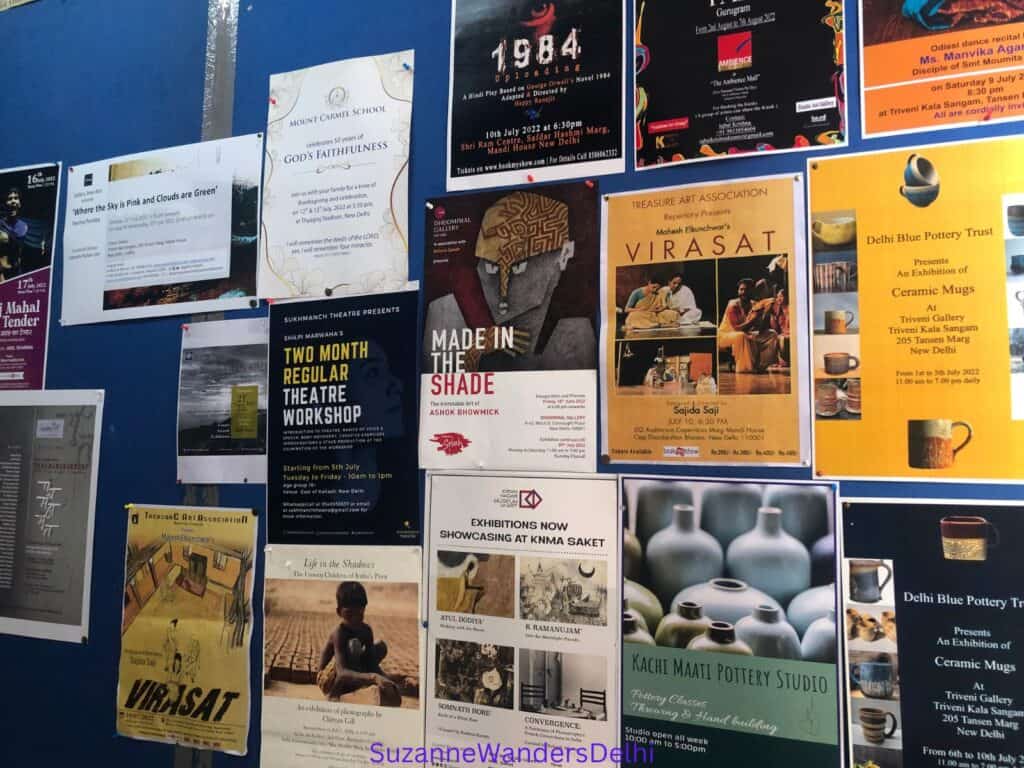
6. Take an Indian Dance Class
Want to learn the lively and cheerful bhangra or the latest moves from Bollywood? Take an Indian dance class, like the ones offered by Delhi Dance Academy. They have a special 2 hour workshop for visitors which covers bhangra, Bollywood and dandiya dance.
7. Learn How to Cook Indian Food
Indian food is considered one of the best cuisines in the world. A cooking class is a fun way to experience the culture and learn a few new dishes.
I’ve done a few cooking classes in Delhi, and the best ones I’ve taken are with Jyoti Agarwal of Gourmet Desire. Jyoti shares her knowledge of Indian ethics, table manners and food customs with her clients. Best of all, she can take you to the local spice and vegetable markets, a great experience for anyone coming to Delhi for the first time.
8. Enjoy the Delhi Night Life
Delhi has an amazing night life. There are beautiful outdoor bars for listening to soulful Sufi music, clubs with live contemporary music, high energy bars, all night dance clubs, sports bars and comedy clubs. Delhi has it all, and some of the venues are truly magical.
Most first time visitors to Delhi are surprised at how good the night life is. Read more about the best party places in Delhi.
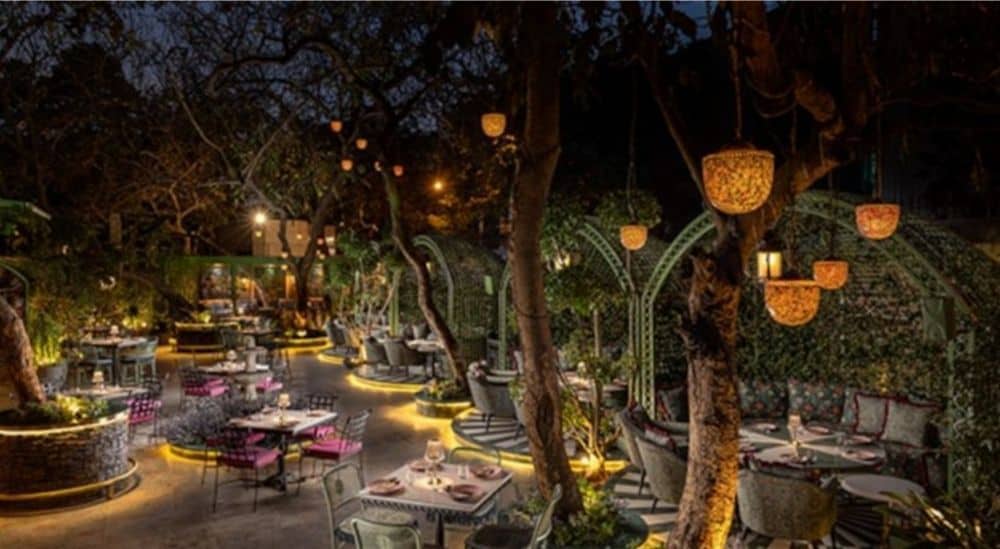
9. Take a Sightseeing Tour of Delhi
Taking a guided tour of a new destination can be a wonderful way to explore and get more comfortable in a new place. Any of these 6 sightseeing tours of Delhi will get you off the beaten path, and you’ll benefit from a local’s knowledge of this sprawling mega city.
And Even More Places to Visit if it’s Your First Time in Delhi
STILL looking for more places? Let these articles guide you!
- 29 Amazing Things to Do in Delhi
- Exploring the Charms of Old Delhi: 20 Top Things to Do and See
- Taj Mahal Sunrise Tour from Delhi: Three Great Options
The Wrap-Up on First Time in Delhi: The Complete Guide and Itineraries for Delhi
Delhi has so much to offer for those that are willing to explore the city. It is one of those places that grows on you over time, as you start to appreciate everything there is to see and experience. So take the time and give Delhi a chance, you won’t be disappointed. This may be your first time visiting Delhi, but it won’t be your last.
Don’t forget travel insurance! It’s always a good idea to carry travel insurance just in case something goes wrong. I really like and use SafetyWing
